
Home » Guides » How To Winterize A Travel Trailer (Step by Step Guide)

How To Winterize A Travel Trailer (Step by Step Guide)

- Last Updated: Apr 21, 2024
When the cold weather starts to creep in, it’s time to start thinking about winterizing your travel trailer. If you want to ensure that your trip is a success, you must take the necessary steps to prepare for the colder months. This article will discuss how to winterize a travel trailer so that you can stay warm and comfortable on your next trip!
Why Do You Need To Winterize Your Travel Trailer?
There are a few reasons why you might need to winterize your travel trailer. First, if you live in an area with cold weather, you will want to ensure that your travel trailer is prepared for the colder temperatures . Second, if you plan on taking a trip during the winter months, you will need to ensure that your travel trailer is winterized correctly to stay warm and comfortable while on the road.

What Happens If You Don’t Winterize Travel Trailer?
Depending on where you live, you may be able to get away without winterizing your travel trailer.
However, if you live in an area where the temperatures dip below freezing, it’s essential to take the necessary steps to protect your investment . Failing to do so could result in severe damage and costly repairs.
So what exactly happens if you don’t winterize your travel trailer? Water lines can freeze and burst, causing extensive damage. The holding tanks can also freeze and crack, resulting in leaks.
And if the RV is left unattended for an extended period, the battery could die. All of these scenarios are costly to fix and could have been avoided by taking the time to winterize the RV.
Related>> How Tall is a Travel Trailer? (And Why You Need to Know)
When Should I Winterize My RV?
The best time to winterize your RV is before the first frost. This will help to ensure that your lines and pipes don’t freeze and burst. However, if you live in an area with a mild climate, you may be able to get away with winterizing your RV later in the season.
No matter when you decide to winterize your travel trailer, the most important thing is to do it before you take it out for the season. This will help to ensure that your RV is ready for anything that winter throws your way.
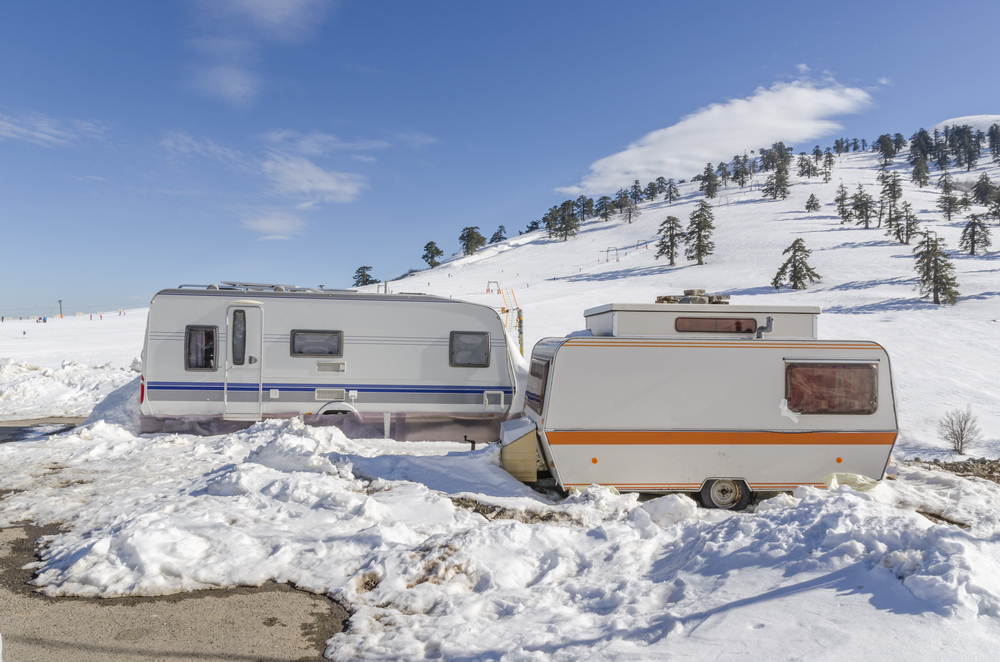
Tools Needed Before You Start
To winterize your travel trailer, you’ll need a few tools. These include:
- A water heater bypass kit
- A clean and empty five-gallon bucket
- Air compressor
- An RV antifreeze solution (this is different from the automotive antifreeze method)
- Pressure relief valve
- A rags or towels
Once you have all of these things, you’re ready to start winterizing your travel trailer!
How Do You Winterize Your Travel Trailer? Simple Steps To Follow
If you are like many people, you enjoy spending time outdoors in your RV during the warmer months. However, when winter arrives, it’s essential to take steps to protect your investment. Winterizing your travel trailer will help ensure it is ready for next season.
Here are some simple steps that you can follow to winterize your travel trailer:
Step # 1: Clean And Inspect The Roof And Seal Any Leaks
Begin by removing any leaves or debris accumulated on the roof throughout the fall. Next, inspect all the seals around your vents, skylights, and other openings. If you see any cracks or gaps, use a sealant to fill them in and prevent leaks.
Step # 2: Drain The Freshwater Tank And Add RV Antifreeze To All Faucets, Showers, And Toilets
- Open all of the faucets in your travel trailer to allow any water left in the lines to drain out.
- Add RV antifreeze to each one.
- Drain plug on the fresh water tank and add RV antifreeze to that as well.
To do this, pour a few inches of RV antifreeze into a bowl and then use a funnel to add it to each toilet bowl. For your sinks and showers, turn on the faucet until you see the antifreeze coming out, then turn it off. Non-toxic RV antifreeze is safe for humans, pets, and the environment.
Related>> Top 10 Best Toilets for RVs (2022 Review)
Step # 3: Add Antifreeze To The Toilet Bowl And Holding Tanks
Add a few inches of RV pump antifreeze to winterize your toilet to the bowl. Next, flush the bathroom several times until the antifreeze appears in the bowl. Inline water filters, turn off the bypass valve, and open all of your RV’s faucets until the antifreeze comes out.
Step # 4: Disconnect And Drain The Battery
To winterize your battery:
- Start by disconnecting it from the power source.
- Use a hydrometer to test the level of acid in each cell. If the level is low, add distilled water until it reaches the fill line.
- Charge the battery fully before storing it for the winter.
Related >> Top 10 Best RV Batteries For Boondocking (2022 Review)
Step # 5: Cover Or Remove Any Exposed Water Lines
To protect your water lines from freezing temperatures, start by disconnecting them from the water source. Next, drain any remaining water from the pipes by opening all the faucets in your travel trailer. Finally, either cover the lines with insulation or remove them entirely and store them indoors for the winter.
Step # 6: Remove All Food From The Refrigerator And Freezer
To prepare your refrigerator for winter:
- Start by removing all of the food from it.
- Clean the interior and make sure there is no mold or mildew present.
- Turn off the power to the fridge and prop the doors open to prevent ice buildup.
Step # 7: Cover The Windows To Help Insulate The Trailer
To help insulate your travel trailer:
- Start by covering the windows with plastic.
- Use weather-stripping to seal any gaps around the doors and windows.
- Consider adding a layer of insulation to the walls and ceiling of your trailer.
Step # 8: Store Your Trailer In A Safe And Dry Location
When it comes time to store your travel trailer for the winter, make sure to choose a safe and dry location, if possible, avoid storing it outdoors where it will be exposed to the elements. Instead, opt for a spot in your garage or shed. Winter storage is typically available at most RV dealerships.

By taking these simple steps, you can help to ensure that your travel trailer is ready for winter. Contact a local dealer or service center for more information on winterizing your RV. They will be able to assist you with any questions that you may have.
Wrapping UP
Now that you know how to winterize a travel trailer, it’s time to get started! This process may seem daunting at first, but it’s actually quite simple. Just be sure to take your time and follow the steps carefully. Before you know it, your trailer will be ready for winter!

Leave a Comment Cancel reply
Recently published guides.
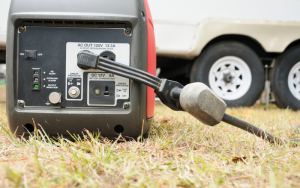
Buying a Generator for RV Life
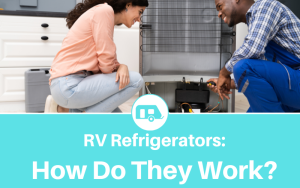
RV Refrigerators: How Do They Work?

How to Repair Norcold Fridge Flap

This post may contain affiliate links or mention our own products, please check out our disclosure policy .
How To Winterize An RV in 9 Easy Steps
Published on July 27th, 2018 by Ray & Tammy Roman This post was updated on March 19th, 2024
This guide shows you how to winterize an RV in 9 easy steps. Winterizing your camper is not too difficult if you follow clear and concise, step-by-step instructions. In this beginner guide to winterizing an RV, you’ll find all the steps you need to successfully prepare your RV for winter storage.
This is a comprehensive guide to RV winterizing, so I’ve broken it down into manageable steps. I’ve curated the best videos on the subject to help you along. Let’s get started with nine easy steps to winterize an RV.
What You Will Need To Winterize your Camper
- Non-Toxic RV Anti-Freeze: The amount you will need depends on your RV’s plumbing layout. Plan on needing about 4-6 gallons of antifreeze; give or take a few quarts. I recommend the RecPro RV Non-Toxic Anti-Freeze, available in a 4-gallon (ca. 15 liters) pack on Amazon. DO NOT USE AUTOMOTIVE ANTIFREEZE.
- Water Heater By-Pass Kit: Some, not all RVs, come with a built-in water heater by-pass, but if yours doesn’t, you’ll need a kit to bypass the tank. The Camco Water Heater By-Pass Kit is the one I recommend. Make sure you get the right length for your tank.
- Holding Tank Cleaning Wand: I recommend a cleaning wand to clean sediments from your RV water heater. Camco’s cleaning wand is one of the best and most affordable available.
- Water Pump Converter Kit: This allows you to use the RV water pump to inject anti-freeze into your pipes easily. This Camco Permanent Pump Converter Winterizing Kit is the one you want to use.
- Basic Hand Tools: To remove drain plugs and loosen obstructions that may be in the way, you’ll need some basic tools such as an adjustable wrench, pliers, screwdrivers, etc.
- Owner’s Manual – It helps to have a copy of your owner’s manual to ensure you are doing things properly and are not missing any steps.
9 Steps To Winterize Your Camper
As you can see from the list, winterizing an RV is not overly expensive. It’s important, however, to have these supplies on hand before you get started, as it allows you to get your RV winterized without any delays.
DON’T MISS OUT ON RV LIVING UPDATES
Sign up for the newsletter today.
Please enter a valid email address.
An error occurred. Please try again later.

Thank you for subscribing to the RV Living newsletter, keep your eye on your inbox for updates.
I highly recommend you read your owner’s manual to learn about any winterizing guidelines that may be specific to your camper.
Familiarize yourself with all the steps below before you begin.
Step 1. Disconnect any outside water source
The first thing you’ll want to do is disconnect any outside water source that may be connected to your city water inlet. You will also want to disconnect any inline water filters or bypass them if they have a bypass.

Step 2. Drain Your Fresh Water Tanks t the Low Point Drain Lines
Draining your freshwater tank is simple and shouldn’t take too long. There is usually a single hose coming out from the underbelly of the RV. There is a valve you turn to let the water out. That will easily and quickly drain your fresh water tank.

Step 3. Drain and Flush Gray and Black Holding Tanks
Some RVs have a tank flushing system built-in, so simply engage that to clean the tanks. You’ll need to do it manually if your RV doesn’t have a tank flushing system.
You’ll need to drain your black and gray water tank. Clean your black and gray water tanks using a cleaning wand.
Both your black water tank and gray water tank terminate at a valve. Lubricate the termination valves with WD-40.

Make sure to dispose of the content at a proper dump station.
Step 4. Drain Your Hot Water Heater Tank
Never drain your hot water tank when the water temperature is hot or under pressure.
First, turn off the breaker to your RV water heater as a safety precaution. This will prevent you from accidentally starting the water heating element with no water in the tank.
Let the hot water cool down. When you are sure the water is not hot, go outside your RV and open the panel to access the water tank.
Next, find the tank drain plug typically located near the bottom of the tank. Loosen the drain plug using an adjustable wrench and remove it. Be careful when removing the drain plug as it is usually plastic.
On Suburban brands of hot water heaters, the drain plug is also an anodized rod, remove it, and the water inside the tank will start to run out.
To help the water drain quicker, open the pressure relief valve at the top of the tank.

Step 5. Drain your water system
Open all hot and cold faucets inside and outside your RV. Don’t forget the toilet valve and if you have an outside shower it also needs to be open. Now it’s time to drain your RV water lines.
First, you need to locate the low-point water line drains. They are usually located underneath your RV near the tank. There is a hot water line and a cold water line.
Here is a video showing you the typical location of the low-point water line drain valves, plus an easy tip to modify for future use.
Next, run the water pump for a bit to help force any water out. Turn the water pump off as soon as the water has drained. Be careful not to run the water pump without any water in the system for too long, or you might ruin the pump.
Step 6. By-pass your water heater
In this step, we’re going to bypass your water heater. Doing this prevents you from filling your tank with RV antifreeze, saving you as much as 6 to 10 gallons of antifreeze. Some RVs come pre-equipped with a bypass system, but many do not. If yours does not have a bypass system, you must purchase a water heater bypass kit and install it. I recommend this one by Camco .
Remember to use an air compressor to blow out your water lines. You just have to be careful not to use too much air pressure during the process; 30-35 psi is sufficient.
How To Use Water Heater Bypass Valve (Video)
In this video, you’ll learn how to operate the bypass valve in your RV water heater. It’s very simple and once you understand how to do it, winterizing your RV becomes much easier.
Step 7. Add anti-freeze (Non-Toxic RV Anti-freeze)
Let’s add the antifreeze. There are typically two ways to add antifreeze to your travel trailer. You can use a water pump conversion kit and add the antifreeze from the inside, or you can use a hand pump and add the antifreeze from the outside.
To check your progress, you must open up one faucet at a time. Begin with the kitchen faucet, open the hot water, and keep it open until antifreeze flows through it.
Once the output from the hot water faucet is flowing with pink antifreeze, you will know that antifreeze is in that system, and you can close the faucet.
Do the same with the cold faucet side. Do this with all faucets working from the highest, which is usually the kitchen faucet, to the lowest, typically the bathroom in the shower, and finally flush the toilet until antifreeze flows into the bowl. Make sure pink antifreeze is flowing from your shower head as well.
How To Add Antifreeze to an RV Plumbing System (Video)
Step 8. Pour anti-freeze in the shower and all sinks
At this stage of the process, you will want to pour a cup of antifreeze, or in some cases, two cups of antifreeze, into the shower drains, and kitchen sink drains. Don’t forget the toilet bowl as well. If you have an ice maker, washing machine, or an outside shower, you will want to winterize those. For those accessories, check your owner’s manual on how to winterize them.
Step 9- You now are done winterizing your travel trailer
Once you have completed all the steps above, go through your RV and make sure all faucets are closed.
Additional Tips To Winterize An RV
Here are some additional tips before you place your travel trailer and storage.
- If your RV is equipped with a dishwasher or ice-maker, check the owner’s manual in how to winterize those appliances.
- Clean out your refrigerator, freezer, and pantry, and remove anything that can spoil and will not attract rodents. Leave the door open during storage to prevent mold and mildew buildup in your fridge.
- Perform thorough cleaning on the interior of your travel trailer.
- Perform an exterior inspection and check for areas that might need caulking or repair.
- Your sewer hose will probably need cleaning before you start it.
- Thoroughly wash the exterior of your RV and wax.
- Clean the awning rollout and the awning fabric with an awning cleaner. Let it dry completely before you roll it up.
- Elevate your RV using leveling jacks, so your tires are off the ground. This prevents your tires from developing flat spots while in winter storage.
- Remove and store your propane tanks.
- Cover any roof vents to prevent insects from entering
- If you own a motorized RV, add some fuel stabilizer to the fuel tank.
Below is a video showing the winterization of a typical travel trailer.
How To Winterize and RV Checklist PDF
What better way to winterize your RV than with a handy RV Winterization Checklist in PDF that you can easily print out and use? Below are links to 3 checklists you can print out and use for free.
- Advanced RV Checklist
- RV Winterizing Your RV Checklist
- RV Winterizing Checklist
Final Thoughts
Winterizing a travel trailer or motorhome is not a difficult task. The steps above are very general, and some may or may not apply to your particular travel trailer. I encourage you to check your owner’s manual for the exact steps needed to winterize your travel trailer or hire a professional to do it for you.
The steps to winterize an RV will work for all campers, including off-road campers with a water system.
Don’t own a travel trailer just yet? If you are thinking of buying one in the near future, check out our top-rated travel trailer brands post.
If you enjoyed this post Please Share:
Related posts:.

RV Antifreeze FAQs (with 7 Steps to Winterize Your Camper)
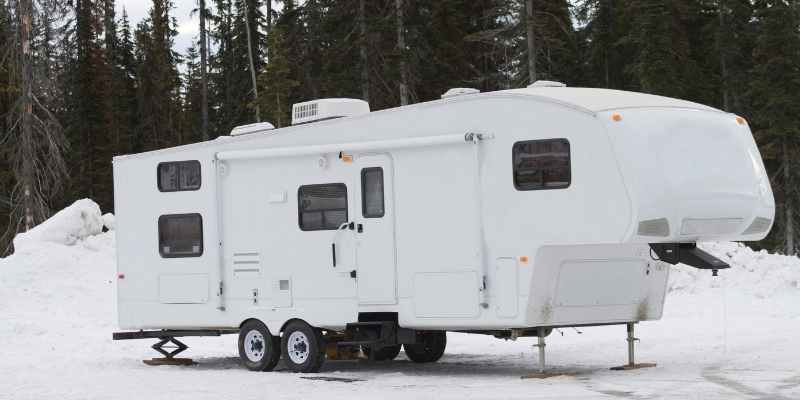
Top 4 Best RV Antifreeze
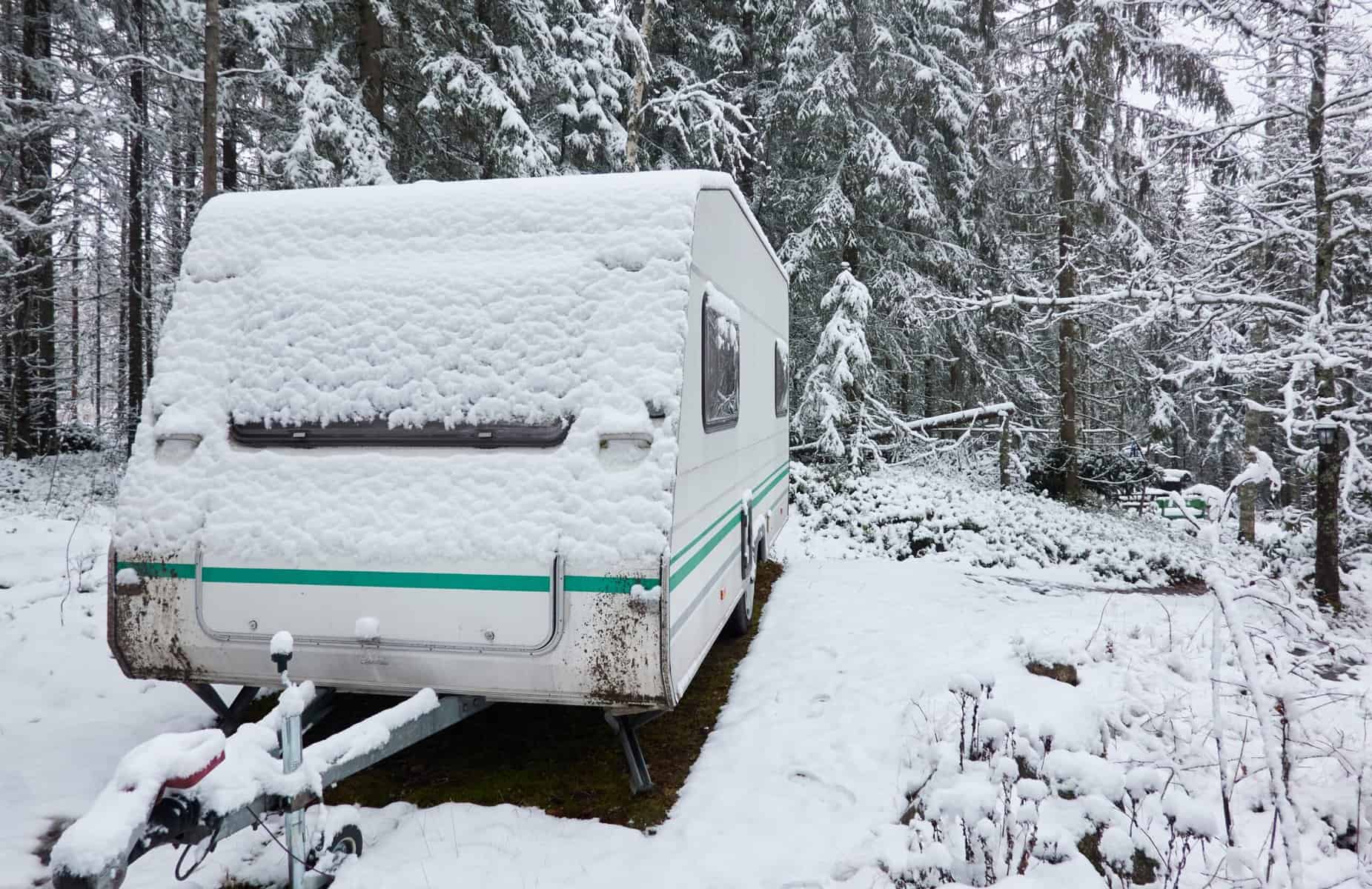
Can Travel Trailers Be Used for Winter Camping?
About the author:.

- Find a Location
How To Winterize Your RV
If you follow all of the steps as outlined, your RV will be as ready as it can be for winter storage. A properly winterized RV means less headache and stress when spring comes around again.
1. Drain and Flush the Black and Gray Water Tanks
It’s extremely important to not let wastewater sit in your RV all winter long. Not only can those tanks be a breeding ground for all kinds of bacteria, but the water can also freeze and cause issues. Drain both, starting with the black water tank and then the gray water tank. Once both are drained, clean the black tank with a special black tank cleaner or a cleaning wand.
2. Drain and Flush the Water Heater
You’ll also need to get the water out of your RV water heater . This means you need to turn it off and let it cool down, and not be under pressure. Hook up city water to your RV with the water turned off. From there, you can use your socket wrench to remove the drain plug or anode rod and open the pressure relief valve.
This will let the water drain out. Don’t drain the water heater if it’s hot or has pressure built up. Wait until the temperature and pressure come down. Once drained, turn the water pressure on and flush out the sediment for 2-3 minutes. Remove the anode rod if old and leave it out during winter; make a note to install a new one in the spring.
3. Bypass the Water Heater
Before adding anti-freeze to your RV, you need to make sure you bypass the water heater. You don’t want any antifreeze making its way into the water heater. Some RVs will have a bypass already installed.
To find the water heater, locate where the water heater service door is on the RV’s exterior and line that up with where it feeds inside. More often than not, there’s an access panel inside that you will need to remove. Using your drill and square tip driver bit, remove the panel to access the valves and adjust them to properly bypass the water heater.
4. Drain the Fresh Tank and Low Point Drains
Be sure the water pressure is off before removing the plug and draining the freshwater tank. It’s a good idea to open the faucets to help facilitate flow. When finished, close all the faucets and plug the low-point drains.
5. Locate the Water Pump
Attach the siphoning kit, or if your RV is equipped, locate the siphoning hose and place it inside your gallon of antifreeze. Open the valve. Turn on the water pump to allow the antifreeze to start flowing through the water system.
6. Open External Faucets and Valves on the Outside of the RV
Beginning with the lowest valve and working your way up, open low-point drains valves or loosen the low-point drain plugs to allow water to run out. Do so until the water turns pink (this is the antifreeze making its way thoroughly through the pipes), then close the valves or retighten the plugs. Turn on any outside showers or exterior faucets, running one side (hot or cold) until it runs pink, then close it and run the other.
7. Open Internal Faucets, Showers, and Toilets
Repeating the process from step six, run the faucets inside ( kitchen , bathroom , and showers), starting with one side until it runs pink, then closing it and running the other side. Then do the same thing for all toilets until you see the antifreeze.
8. Pour Antifreeze Down P-Traps
After that, you should pour some additional antifreeze down the drain of each sink, shower, and RV toilet to ensure the exterior termination pipes don’t freeze over winter. With all that done, you should double-check that the water heater’s heating element is turned off and all faucets are closed.
Get Help With RV Winterization If You Need It

If the steps above sound too complicated, or they’re just not something you want to do this season, no worries–we understand. Simply come into your local Camping World location and have our highly qualified service professionals do it for you. Doing it yourself can be rewarding, but paying professionals to handle your home on wheels is never a bad idea.
For other winterization tips and tricks , check out your RV’s owner’s manual. It’s common for different classes of RVs, such as Happier Camper , and different appliances to have additional needs before you can properly store your RV for the winter. After all, a successful winterization leads to a successful spring when RV season rolls around again.
Want to schedule a winterization service visit? Or consult with a Personal RV Shopper to locate a new, perfect RV for you? Find the Camping World RV service center near you !
Do you have any questions about winterizing your RV? Leave a comment below and we’ll respond ASAP!
- Comment (39)
Excellent step-by-step guide for winterizing an RV! The detailed instructions and visuals make the process seem much less daunting. Properly preparing your rig for winter storage is crucial to avoid costly repairs later. I’ll be bookmarking this article as my go-to reference.

So glad you found it useful Gary!
Should cupboard doors be left open?
I doesn’t hurt to leave cabinets and what not open just for airflow. If any moisture was in those area’s it could start to mold or create an unwanted odor. Hope that helps!
Found in step 2 detail: “Once drained, turn the water pressure on and flush out the sediment for 2-3 minutes.”
Hi Brad, please see my reply to your other comment for clarity, but don’t hesitate to let us know if you have other questions about the process!
Why “Hook up city water to your RV with the water turned off” in step 2?
2. Drain and Flush the Water Heater You’ll also need to get the water out of your water heater. This means you need to turn it off and let it cool down, and not be under pressure. Hook up city water to your RV with the water turned off. From there, you can use your socket wrench to remove the drain plug or anode rod and open the pressure relief valve.
This will let the water drain out. Don’t drain the water heater if it’s hot or has pressure built up. Wait until the temperature and pressure come down. Once drained, turn the water pressure on and flush out the sediment for 2-3 minutes. Remove the anode rod if old and leave it out during winter; make a note to install a new one in the spring.
The city water will be used to flush the water heater tank once it’s drained. Hooking it up with it off just means to leave the spigot at the city water connection off until the tank is initially drained. Hope that clarifies things, but let us know if you have any follow up questions!
Should I drain the antifreeze or blow it out of the lines or is the idea to keep the system full of fluid. Also some treads suggest undoing the lines in and out of the pump. Seems like it could get messy. I’m in Central Alberta so -40 is highly possible.
No need to drain.
You should definitely leave the antifreeze in the lines, but you’ll need the proper extreme duty RV antifreeze rated for those frosty temperatures. That antifreeze should last 2-5 years in the sealed lines. The water hear, fresh tank drain, and holding tanks should be left empty. When winterizing, care must be taken to ensure that the antifreeze is pumped through the city inlet, water pump, low point drains, outside kitchens, outside shower, shower heads, filter housings, ice makers, dishwashers, washing machines, accumulator, screen filter bowls, toilets, tank flushes, etc.
Winterizing isn’t the quick, simple job it once was. If you have any reservations, your local Camping World can provide a Complete or Deluxe Winterize for them. Here’s where you can find a service center near you: https://rv.campingworld.com/rv-service-maintenance#js-anchor-locations
I drained all the water out of the tanks then put three gallons of antifreeze in the fresh water tank. I turned on the water pump and nothing came out of the faucets. Where do people in the videos get the water that flows from the faucets before it turns pink if everything is empty?
My winterizing process is somewhat less complicated. Mid October, load up DPtag, hook up one of the Jeeps, shut down bricks’n’sticks, fuel up, take I-70 West to I-35 @KCMO, hang a lazy louie, set cruise on 70, out run the cold. Reverse process about April, or May, or maybe NOT. Easy, peasy, works every year. We don’t camp. We LUXURIATE!!!!!
There seems to be disagreement over whether you open a faucet or close the faucets after winterization. You said, close all faucets. Is it o.k. To leave a faucet or two open for possible expansion? Thanks!
Thanks this was very helpful.
What do we do to keep our RV from freezing during the winter when in use!! We use ours years around.
If I use an air compressor and blow the water out of my lines is it necessary to hook up to my water pump and run antifreeze through my lines. If I blow out the water and pull my water heater plug then run antifreeze down my P traps will I be ok,
I keep an electric heater on in my garage bathroom to keep pipes from freezing over the winter. Is it possible to do the same in the RV.
If all (or nearly all) the water has been drained from the system, why is antifreeze necessary? It seems like even if a little bit of water were left in the system somewhere, it would have room to expand in a mostly empty system.
Where is the switch to turn on and off the therma heat as stated in the owner manual? Class C forester.
I have food trailer with a 20gal fresh water tank, a 50 gal black water and an instant propane water heater. We will be using the water on several occasions maybe every other week or so but while it sits in between events how do we keep the water from freezing? Is this something we will have to do everytime we get ready to store it for a week a or two?
I might be camping in the winter if the temperatures stay above freezing. Is there anything I can do to prevent my pipes from freezing in between camping trips? Can I winterize the tank and still go camping if I don’t use the water or toilet?
If i use an air compressor to blow all the water out of the lines, do I still need to put antifreeze in them?
What do you charge to winterize a thor ace 27.1
Hi Annamarie!
I’d recommend contacting your local Camping World service center directly: https://rv.campingworld.com/rv-service-maintenance
They can give you pricing and info on our two winterization packages!
Hi Judy! If water flows from the faucets before it turns pink (or the color of the antifreeze you use), that tells me there was still water in the system. That might not be a significant issue if the ratio of water to antifreeze is roughly 50/50. But some antifreeze bottles are pre-mixed (i.e., already a 50/50 solution). Did you use a pre-mixed solution or a 100% antifreeze?
Also, are your faucets and low point drains closed again before you turn on the water pump to circulate the antifreeze? If the system is open (i.e., a faucet or low point drain is open), it will be harder for your water pump to build pressure to circulate antifreeze. Feel free to follow up if you have additional questions. I’d love to make sure your RV’s plumbing is safe as we move through these winter months!
Thanks for sharing Scott!
You’re spot on about the possibility of residual water remaining in the lines when using air to blow them out. Antifreeze is a safe bet for long-term winterization.
Great call Joey!
I’ve personally taken this approach myself over the last few years. Do you ever head to any of these snowbird destinations?
https://blogcw.local/the-rv-life/where-to-go/unsung-snowbird-destinations-for-rvers/
I used air pressure for years in Virginia; my first two years in Colorado I lost waters pumps. The technician advised me that blowing out the lines leaves some residual water, even condensation from extreme temperature changes can freeze, expand and blow seals in the water pump. Anti-freeze is a cheap solution when considering the cost of replacing broken pumps. I also leave all the knife switches on the tank outlets open. Even when drained, condensation can build and cause freezing that will prevent the knife switches from opening/closing. (We take out our fifth wheel and the end of February and de-winterize that day before our departure for warmer climes)
I wondered the same thing. It works for our sprinkler system, and I wouldn’t think it would be difficult to do it. Drain the water lines and blow out the gray water drains. It might cause some issues with the gray water tank smell getting into the trailer past a cleared P trap. At a minimum, it would drastically reduce the need for antifreeze. Black water tank would have to stay with antifreeze treatment, so I guess that actually would fill all the lines anyway.
Great question. Let’s clarify:
If you do a basic winterizing, it’s okay to leave the valves open on the faucet and low-point drains. If you do a complete or deluxe winterize with antifreeze, it’s best to leave them closed, so they don’t drip antifreeze on the plastic sinks or shower pans. The antifreeze will get slushy but not freeze solid to be able to expand and crack a fixture. We’ve never seen damage from closing the faucets with antifreeze in the system. If the RV has been properly blown out there is no reason not to close the faucets, as there would be no water to expand and damage them.
Hopefully that clears things up, but let us know if you have additional questions!
What fo you charge to winterize class c 26foot.
Hi Gary, reach out to the service department, and they’ll be able to give you a quote! https://rv.campingworld.com/service
Yep! The storage space underneath the RV is often called a basement. This is where I’d put a small space heater if the plumbing runs through there (most of the time it does). It really depends on the unit. Some travel trailers won’t really have a basement like a motorhome or a fifth wheel.
What do you mean the basement of my RV? Do you mean underneath the RV?
Hey, Paul. Yeah, you can use a small space heater in the basement of your RV that should help keep your pipes warm enough to keep from freezing. Also, there are heating pads you can add to your holding tanks.
Hi Warren, I’m not familiar with your particular model. I’d say give the nearest Camping World dealership a call. They’ll be able to help you out
Hey Don, If the RV is in freezing temperatures you may have to or find a way to keep the tanks and water lines warm. You can buy heating pads for your tanks that should help keep them from freezing.
Hi Sue, if you’re not actually using the water system I would think you’d be okay. The other option is to get heating pads for the tanks and make sure the lines and tanks never get cold enough to freeze.
Leave Your Comment Cancel Reply
Save my name, email, and website in this browser for the next time I comment.
Shop By RV Type

Your Adventure Awaits
Copyright © 2023 cwi, llc all rights reserved.
- RV Glossary |
- Privacy Policy |
- California Privacy Rights |
- Do Not Sell or Share My Personal Information |
- Targeted Advertising Opt Out |
- Terms of Use

How to Winterize a Travel Trailer in 8 Easy Step-by-Step Guides
Winter can be very challenging for RV owners. As a travel trailer owner, knowing how to winterize a travel trailer is essential, especially if you’re new to the RV lifestyle.
One of the first RVing problems we encountered early was due to lack of winterization. As a newcomer to the RVing world, we weren’t familiarized with the process and the need to winterize our travel trailer .
This mistake cost us a fortune, and as soon as winter was over, our propane tank was gone, and our plumbing system was completely damaged as a result of water freezing in them. We had no choice but to begin repairing and replacing the damaged parts.
Don’t let this happen to you. Winter will soon be upon us. Wintering your rig can be a little time-consuming, but putting in the work always pay off, provided you have the right tools and knowledge.
To continue exploring new destinations and maximizing your outdoor experience, winterizing your travel trailer will secure your leisure and investment.
Steps on How to Winterize an RV or Travel Trailer
Now, let’s quickly dive into how to winterize a travel trailer .
Step 1: Clean and Inspect All Parts
Before winterizing your travel trailer, spend some quality time cleaning and inspecting both the interior and exterior of your trailer.
This step is the first because you want to avoid dirt or other elements that could interfere with the process.
Start by removing food items or debris from the trailer’s interior to prevent mold or mildew growth during winter.
Check thoroughly for any signs of damage – it might be as little as cracks in the walls or floors; see if there are leaks in the roof or possible worn-out tires.
Ensure to properly seal all windows and doors to avoid any drafts or leaks.
Use a mixture of clean water and detergent to remove all accumulated dirt from the exterior of your travel trailer over time.
Remember to inspect the roof, awning, and other exterior parts for any signs of wear and tear.
Spending quality time to inspect and clean your travel trailer will be worth it, as you’ll be able to spot any issues you can’t help but address before winterizing.
This approach will ensure that your trailer stays in good condition throughout the off-season and is ready to use when the camping season returns.
Step 2: Disconnect Batteries and Electrical Appliances
The next step is disconnecting your batteries and electrical appliances to prevent drainage and damage during storage.
Since the storage period can drag on, disconnect the batteries, including the solar panels connected to your trailer.
Disrupt and turn off your batteries, solar panels, and all electrical components, including lights, appliances, and air conditioning.
Store the RV batteries in a cool, dry place, preferably on a battery tender, to maintain their charge.
Disconnect the solar panels by removing the positive and negative cables.
Cover the solar panels with a protective cover to prevent external interference during storage.
Always remember to label all cables for easy reconnection.
Step 3: Drain and Clean Waste Water Tanks
Next, drain your black and grey water tanks and clean them thoroughly to prevent any buildup or odors.
Start by locating the valves for your black and grey water tanks.
Connect your sewer hose to the appropriate tank valve and channel the other end into a nearby portable tank.
Open the black water tank valve first, and allow the water to drain completely. It’s essential to empty the black tank before the grey water tank since the grey water can help flush out any remaining waste.
After draining the black water tank, open the valve for the grey tank to drain. Open the sink and shower faucets to ensure both tanks have no water whatsoever.
Once the tanks are empty, add a cleaning solution following the manufacturer’s guidelines. Typically, you’ll pour a measured quantity of the solution into your toilet bowl and flush it into your black water tank.
Allow the cleaning substance to sit in the tanks for some time. This step is crucial for removing any buildup or odors.
After the substance has had time to work in the tanks, drain the tanks again, ensuring all the cleaning solution is flushed out. You may need to rinse the tanks a few times to ensure they are spotless.
Disconnect your sewer hose and keep it away from your freshwater hose to avoid cross-contamination.
Properly draining and cleaning your waste water tanks will prevent unpleasant odors or buildup from developing during the winter months.
Step 4: Drain Fresh Water Tank and Water Lines
Next, drain your fresh water tank and all water lines. Apply compressed air to blow out any remaining water from the pipes.
Follow the steps below.
Turn off the water pump and release pressure through all faucets and valves.
Locate and connect a hose to the freshwater tank drain valve.
Allow all of the water to drain by opening the drain valve.
Close the drain valve, then remove the hose once the tank is empty.
Next, locate your water lines’ low-point drain valves. There could be more than one, so it would make sense to consult your manual to see how it’s done or let a professional put you through it if you need clarification.
Allow all of the water to drain by opening the low-point drain valves. Though it depends on your type of travel trailer, and in most cases, you will need a wrench to open the valves.
Close the low-point drain valves and disconnect any hoses or attachments used to drain the water once all of the water has completely drained.
Finally, blow out any remaining water from the lines with compressed air. Connect an air compressor to the city water inlet and blow out each line until there is no more water.
Begin at the closest faucet to the water pump and work outward.
Step 5. Bypass the Water Heater
The next thing in this stage is to turn off the water heater. This is required to prevent antifreeze from circulating in the water heater.
First, turn off the water heater and allow it to cool.
Locate your travel trailer’s bypass valve. This valve is typically found near the water heater or in the water lines that lead to and from the water heater.
Set the bypass valve to “bypass” mode. This will redirect water flow around the water heater, preventing antifreeze from passing through it.
Step 6: Drain the Water Heater
Step 7: add antifreeze to the plumbing system.
After bypassing the water heater, now add antifreeze to the piping system. This is done by injecting antifreeze into the plumbing system with a hand pump or a water pump conversion kit. You can check out your manual for the perfect amount for your trailer.
Pour antifreeze into the tank after finding the fresh water fill port on the trailer’s outside.
Turn on the water pump and keep it running until the antifreeze drains from all taps and drain valves. This ensures that the antifreeze has completely replaced the water.
Step 8. Flush the Toilet and Run the Faucets
After applying the antifreeze to the plumbing system, allow it to sit for a while; now, flush the toilet and run the faucets to make the antifreeze reach all system regions.
Turn on all faucets, including the shower, and leave them running until pink antifreeze appears.
Flush the toilet often to ensure antifreeze is present in the bowl and tank.
Run the hot water faucets to confirm that the hot water lines are antifreeze-filled.
Make sure to flush any outdoor showers with antifreeze.
After ensuring that antifreeze has reached all parts of the plumbing system, turn off all taps and close the toilet valve.
Dos and Don’ts of Winterization
Winterizing a travel trailer has its own dos and don’ts, like several other things. These dos and don’ts matter greatly; you should prioritize them to maintain your trailer.
Do follow the manufacturer’s guidelines for winterization.
Do use non-toxic antifreeze.
Do store your travel trailer in a dry, covered location.
Do inspect your travel trailer regularly during the winter months.
Don’ts:
Don’t use automotive antifreeze.
Don’t forget to drain all water.
Don’t forget to disconnect your travel trailer’s batteries and solar panels before the winterization process.
Don’t store your travel trailer without properly cleaning and inspecting the interior and exterior first.
Most Common Mistakes When Winterizing a Travel Trailer
There are several mistakes people make when winterizing a travel trailer. Here are some of the most common winterizing mistakes you want to avoid:
Not draining and cleaning waste water tanks before winterizing.
Using regular automobile antifreeze rather than RV antifreeze.
Failure to properly disconnect batteries and solar panels before winterization.
Allowing water to remain in the plumbing system.
Failure to thoroughly clean and check the interior and exterior of the travel trailer before storing it.
Placing the travel trailer in an unsafe area without covering or adequately securing it.
Winterizing your travel trailer is critical to protecting it from harsh winter weather and avoiding costly damage. If you follow these walk-in, step-by-step guides, you’ll see that your travel trailer is winterized correctly and ready to use again in the spring.
Remember to thoroughly inspect your travel trailer, unplug the batteries and solar panels, drain and clean all water tanks and pipes, and store it appropriately. Following the dos and don’ts and avoiding common errors will help you complete the winterization procedure successfully.
How hard is it to winterize a travel trailer?
Winterizing a travel trailer is not hard; it can be a bit straightforward process; however, it can also be time-consuming and require thorough attention.
What Happens if You Don’t Winterize Your Travel Trailer?
When you fail to winterize your travel trailer, you risk damaging your plumbing system, water heater, propane, electrical system, and other vital components. The havoc starts with water freezing, expanding, and causing damage to every element it’s in contact with.
This often results in costly repairs when fixing the damaged components. Fixing these components is inevitable. Trust me; you want to hit the road with them since they make up the must-have accessories for a travel trailer.
How Much Does It Cost to Winterize a Travel Trailer?
Winterizing a travel trailer costs between $50 and $300. But the final cost can also vary, depending on whether you do the winterization yourself or hire a professional.
If you handle the winterization process independently, procuring the equipment and materials necessary for the task can cost between $50 and $100 or surpass that threshold.
But, if you assign the tasks to a professional, you might spend between $100 and $300, but this also depends significantly on external factors like your RVing location and the size of your travel trailer.
What are the Tools You Need to Winterize Your Travel Trailer?
To winterize your travel trailer, these tools and materials must be available:.
- RV antifreeze
- Water pump
- Compressed air
- Water heater bypass kit
- Water pressure regulator
- Wrenches and pliers
- Screwdriver
- Rubber gloves
How cold can it get before I winterize my travel trailer?
Ideally, you should winterize your travel trailer when the temperature reaches 32°F or 0°C.
How long can a travel trailer stay winterized?
A travel trailer can stay winterized as long as it is adequately prepared for storage without leaving any droplets of water in the lines and tanks.
7 Best Cold Weather Travel Trailers
7 Winter RV Living Tips: How We Stay Warm All Winter in our RV
How long does it take to winterize a travel trailer
The time it takes to winterize a travel trailer is determined by the RV’s complexity and the extent of the winterization process. It might take 30 minutes to several hours to thoroughly winterize a trailer. However, it is critical not to speed up the procedure in order to avoid missing any critical steps.
Can I use regular antifreeze instead of RV antifreeze?
No, regular antifreeze is harmful and should not be used in potable water systems. When winterizing your travel trailer, always apply dedicated RV antifreeze.
Do I need to winterize my travel trailer if I live in a mild climate?
Certainly, even if you live in a temperate region, winterizing your trailer is always a brilliant idea. Freezing temperatures are still possible, and it is always better to be safe than sorry.
How often should I winterize my travel trailer?
It’s important to winterize your travel trailer once a year before the winter months begin.
Can I skip bypassing the water heater during the winterizing process?
No, bypassing the water heater during the winterizing process is critical to prevent antifreeze from circulating the water heater.
Related Posts

How to Fix RV Air Conditioner Not Blowing Cold Air

How to Level a Travel Trailer in 6 Easy Steps

How to Sanitize RV Fresh Water Tank
- Skip to primary navigation
- Skip to main content
- Skip to primary sidebar
- Skip to footer
Journey With Confidence
A Complete RV Winterizing Checklist

Get Your RV Ready for Winter
Many travelers will use their RVs to travel to warmer areas during the winter, while others will prepare them for a few months in storage. If you find yourself in a situation where you need to winterize your RV, you’ve come to the right place! There are many different things you’ll need to do to help your camper endure the colder seasons, so let’s review our RV winterizing checklist.
The Essential RV Winterizing Checklist
Many of these steps will be quick fixes that can be completed within a few minutes or hours. However, make sure you give yourself enough time to properly prepare your RV for the off-season. Skipping or overlooking steps can lead to devastating consequences and long-term damage. Winter can be a difficult time for an RV, especially if it isn’t properly prepared for winter conditions.
1. Drain water supply
The most important step of winterizing an RV is draining the water supply. During the winter, RVs will be subjected to a wide range of temperatures. If they aren’t being regularly heated and used, the stagnant water that’s left behind can freeze and expand, which will lead to burst pipes, flooding, and other types of structural damage.
There are many to-do items on an RV winterizing checklist, but none of them will do you much good if you don’t address the water situation first. Luckily, it doesn’t take too long to empty the water reserves in most RV. You just need to make sure you’re being thorough.
Begin by draining your holding tanks
This includes everything in the freshwater tank, grey water tank, and black water tank. The freshwater tank can simply be emptied, but the other two will need to be flushed and cleaned.
Winter and early spring is a prime time for bacteria, mold, and other nasty things to build up, so give your RV a fresh start for the season. Use the tank flushing system if you have one. If not, you can use a cleaning wand and/or an RV holding tank cleaning product . Take the contaminated water to your nearest dump station so it can be safely processed.
Empty standing water in appliances
Just because your tanks are now empty doesn’t mean that your RV is completely drained. A small amount of water will linger in appliances like sinks, showers, toilets, ice makers, refrigerators, dishwashers, and washing machines.
Go around your RV and turn on all faucets (cold and hot). Flush toilets multiple times until they run dry. Empty out the water supply for your other appliances.
Use an air compressor to dry water lines
Even after everything has been drained there will still be a bit of moisture left in the pipes. This is why it’s a good idea to hook up an air compressor to your RV water lines.
This step isn’t a complete necessity on an RV winterizing checklist, but it never hurts to stay on the safe side when you’re dealing with water. Use 30-50 psi of compressed air to clear out any remaining moisture in your plumbing system. Once that is complete, replace the caps on the holding tanks and water lines.
2. Use RV antifreeze
Next up, you’ll want to apply RV antifreeze to your plumbing system. This will prevent any warping over the winter when the RV is exposed to fluctuating temperatures.
Bypass water heater
The first thing you’ll want to do when adding antifreeze is bypass the water heater. If you don’t do this, the water heater will have to be completely filled with antifreeze before it will spread to the rest of the plumbing. You will end up wasting a ton of antifreeze (and money) if you don’t first bypass this system.
To do this, you’ll need a kit . Turn off the water heater, disconnect the cold and hot lines, and install the bypass kit according to the directions on the product. Reconnect the water lines and open the bypass, and you’re good to go!
Place RV water line in antifreeze container
Now it’s time to fill the RV plumbing system with antifreeze . Disconnect the RV water line (if you haven’t already done so), and place the end in a container of RV antifreeze (this will usually be a pink or green substance). Usually, you will need 2-3 gallons of antifreeze to winterize an RV, but you’ll need up to 10 gallons more if you aren’t able to bypass the water heater first.
Turn on freshwater pump
Activate the freshwater pump and allow antifreeze to travel through the plumbing system. Turn on the faucets throughout your camper until they start to run pink or green with antifreeze. Flush the toilet several times until the same thing happens. Pour 2-3 additional cups of antifreeze into each drain and toilet. Finally, you can turn off the pump and reconnect the RV water line to the freshwater tank.
Drain water heater
After everything on the RV winterizing checklist is done up to this point, you can return to the water heater. Remove the plug and drain its contents. This is usually done last so that nothing goes wrong with the draining and bypass installation.
3. Clean interior
Now that the vehicle is safe from water damage, it’s time to turn your attention to other aspects of winterizing. Clean out the RV and remove any extra cargo. This will help reduce weight and it will help you declutter. Make sure you don’t leave any food or temperature-sensitive items inside.
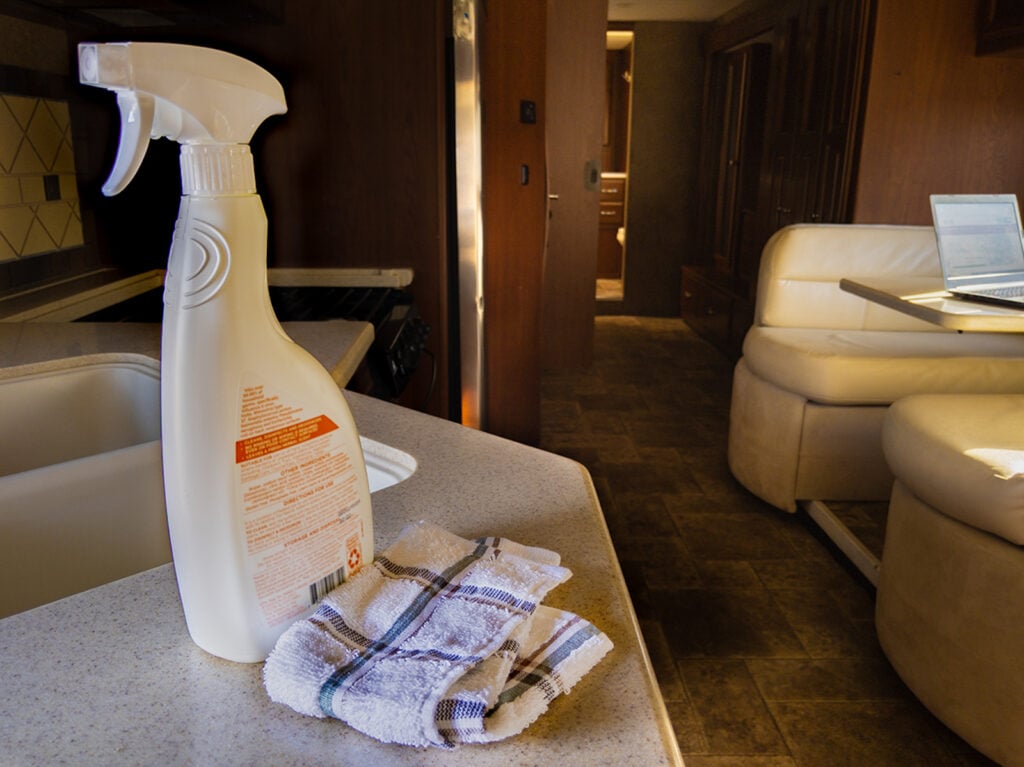
4. Protect against humidity
Major water damage can be avoided by following the steps above, but humidity can still be a pain in the neck. To prevent mold, mildew, or just unpleasant dampness, there are a few things you can do to reduce humidity levels.
Start off by wiping down and drying potentially moist areas of your RV. This includes the bathroom, kitchen, and windows. Add a few desiccants or drying agents in cupboards, windowsills, or secluded corners. Consider using an RV dehumidifier to help keep moisture out.
5. Remove battery
RV batteries are important pieces of equipment, and they need to be protected during the winter. To prevent any possible temperature damage, remove the battery and store it in a temperature-regulated area as long as the RV is sitting unused.
Basements, garages, closets, and crawlspaces are good options where your battery will be out of sight and out of mind. Wrap it in a few blankets to provide an extra layer of insulation.

6. Cover vents
Next item on the RV winterizing checklist: Protect the vehicle’s exterior! By this point, most of the interior issues have been addressed, so it’s time to turn our attention outward.
Begin by protecting all RV exterior vents. If these are left exposed, they provide entry points for snow, ice, humid air, and even infestations. Mice, bugs, and other pests might see your RV as a great place to spend the winter, so make sure they can’t get in. Place vent covers over every opening, and consider adding a layer of plastic wrapping for extra waterproofing.
7. Leave RV on blocks to distribute weight
RVs are sturdy vehicles, but they are still quite heavy. If the entire weight of the RV sits on the wheels for several months, this can cause structural issues and will shorten the lifespan of the tires. To prevent this, use RV blocks to distribute the weight as long as it is sitting unused.
8. Add RV skirting/covers
Now we’ve reached the final step on our RV winterizing checklist! Time to cover up the RV and let it rest until the next travel season rolls around. Install RV skirting around the base and tires to prevent snow and ice from getting underneath.
Add an RV cover that will provide protection against rain, snow, dirt, and wind. It’s easy to buy or make these protective coverings , and something is always better than nothing.
9. Consider storage options
If all of these steps feel like too much of a hassle, or you live in a particularly cold area, you may want to consider other storage options for the winter. For an extra cost, you can store your RV in a temperature-regulated facility.
You will still have to do some level of preparation, but it won’t be nearly as involved. These storage facilities can be quite expensive, but it may be worth the price to you if you want to let someone else take care of everything.
10. Track your RV maintenance
Make sure you keep track of all your RV maintenance and repairs with an online tool such as RV LIFE Maintenance . Not only can you keep all of your documents in one place, but you’ll also receive timely reminders when maintenance is due to help you avoid costly repairs and potentially serious accidents.
Related articles:
- How To Avoid Winter Camping Problems In Your RV
- Covered RV Storage vs Motorhome Covers: What’s Best?
- Is Your Rig Ready For Cold Winter Storage?

No products in the cart.
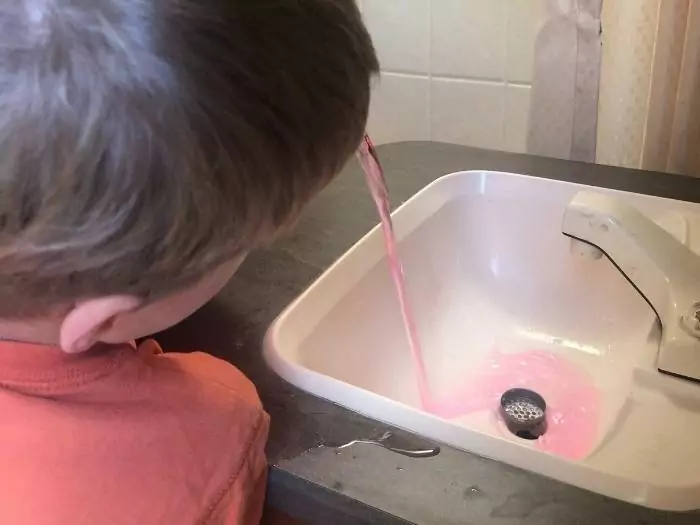
A Guide To Winterizing Your RV (Temperatures And More)
NOTE*** The content on this page may contain affiliate links, we may make a commission. And, as an Amazon Associate, we earn from qualifying purchases. More information: disclosure page .
As an RV owner, you know you need to winterize your RV when cold weather approaches to withstand sub-zero temperatures. Preparing your RV for winter is an essential step in preventing damage and the high cost of repairs. I do this myself every winter (sometimes more than once if we get a surprise freeze). This article will explain the actions you need to take to winterize your RV.
Just so you know when it is time to winterize your RV you first need to know, what temperature will your water lines freeze.
In other words, what overnight temperature should you winterize your RV?
As a general rule, RV water lines will likely freeze when the temperature is below 32 degrees F for 20 hours or below 29 degrees for 3-4 hours. However, anytime the temperature drops below 32 degrees Fahrenheit, water in the lines could freeze.
The cost of paying for winterizing an RV can run up to hundreds of dollars depending on the size and model. However, I do it myself and found it to be relatively easy. This article will explain how you can do this yourself and save a few bucks.
Related Content with more details about winterizing your RV:
- Can RV antifreeze freeze?
- Is it safe to re-use antifreeze?
How you go about winterizing an RV depends a lot on where you live, the climate, and other factors like where exactly you plan to store it (inside or outside).
Pro tip: When you first buy your RV, it will help record yourself doing the walkthrough because later, you can use that video for reference when you need to winterize the vehicle.
While you’re at it, since it will be nearing winter (I assume) because you are reading about winterizing, please do check out the following for winter destinations and tips.
- 11 Magical Places to Camp this Christmas (Best Winter Camping Destinations)
- 11 Breathtaking RV Destinations for December ( for Winter camping)
- Winter Driving Safety Checklist for a Road Trip (34 Expert Tips)
At what temperature should you winterize your RV?
How long does it take for RV pipes to freeze?
To be safe, anytime freezing (below 32 degrees F) nightime temperatures are forcasted its time to winterize your RV. However, it likely takes 24 hours below 32 degrees or 3-6 hours below 25 degrees before RV lines begin to freeze and burst.
There are four zones in the USA that will typically drop below zero in the winter and thus require winterizing your RV. These zones are already laid out for the purposes of agriculture, so we’ll look at these same zones according to the USDA : Zones 3, 4, 5, and 6.
The signal to winterize is 32 degrees F (0 degrees C) which is the freezing point of water. Depending on which state you live in, this could range from October to December, with central US states like Michigan to Kansas typically experiencing frost sooner than either of the country’s east or western shores.
Simple Steps To Properly Winterize Your RV
- Clean the interior of your RV. Remove everything that doesn’t serve a purpose, and empty the drawers and cupboards. All the beddings should be cleaned, including towels and other linens. Electric appliances should be unplugged before cleaning.
- You should empty the refrigerator, so if you have to defrost the freezer, start there and empty it.
- It would help if you examined the RV for possible openings that might create an opportunity for water, or bugs or mice to get inside in the cold season. If you find an opening, plug it with non-rusting material to prevent rodents from entering your unit. Read more about preventing mice here
- Cedar chips, smelly soap or dryer sheets placed at the entrance to the RV will help prevent mice and insect infestation.
- Clean the exterior of your RV and eliminate debris that gets into the slides and seams. It can cause leaks if left unchecked.
- Check that the vehicle’s exterior doesn’t have any damage that requires repair before winter kicks in. Call and schedule repairs as early as possible.
- The RV’s freshwater reserves should all be entirely drained, including water in the holding tanks, toilet, water heater, and waterlines.
- Get some RV antifreeze into your water system.
- , and if you don’t plan on using paid storage, ensure that the exterior of the RV is covered to prevent leaks.
- RV tires should also be covered to prevent rot. Damage.
- All RV doors, windows, slides, and storage compartments should be locked or sealed throughout winter.
How To Protect Your RV In Winter

Here are the questions you have with the answers you need for winterizing your RV. Let,s get this wrapped up with some tips, tricks, and questions answered about your asset’s winterization.
1. Protect Your Pipes From Freezing Temperatures
It is probably the first place you want to start when preparing your RV for winter. The RV’s plumbing is highly vulnerable to freezing, and when this happens, the pipes can burst or crack – either way, you don’t want to start installing new plumbing after every winter. It is possible to leave your RV plugged in during the colder months and use a tank heater to keep the water from freezing.
This isn’t generally an option, so start by emptying all the water from inside your rig. As long as there’s water inside, low temperatures will cause it to freeze, which isn’t good for your plumbing.
Start by opening the low water drain lines to your freshwater holding tank. Drain your waste tanks to a proper facility.
Now you have 2 options for removing water from your interior lines. 1. Then use your compressor or have a professional blow out your lines. 2. Pump RV antifreeze through your water system inside the camper. I do it myself and pump RV antifreeze.
Do whatever it takes to keep your RV dry before the temperature drops.
2. What Temperatures Do RV Water Lines Freeze?
As a general rule, RV water lines will likely freeze when the temperature is below 30 degrees for 2-3 hours. However, anytime the temperature drops below 32 degrees Fahrenheit, water in the lines could freeze.
There are several factors at play here, so it’s not likely that all RV water pipes will start freezing at the same temperatures. That said, you should pay attention when the weather drops to 32 degrees Fahrenheit. I took my camper out of the early season and de-winterized everything. After parking back in storage, I checked the weather and was up all night worrying about the low temperatures that were forecast that night.
The important thing to know about when your RV water lines will be damaged is both temperature and duration.
What you, consider doing is using RV antifreeze, which is safe for aluminum and steel tanks. If for some reason, you didn’t winterize the RV on time, and the temperatures drop to freezing, you may still be able to save your plumbing if you run the heater on low. It may be a bit costly but may keep you from having to pay for complete plumbing the next time you want to take your rig out.
3. Should I Blow Out The Pipes Or Use Antifreeze?
There are a couple of ways you can keep your pipes safe in the cold:
- Pump antifreeze into the lines to keep from freezing, or
- Use compressed air to blow out the water from the pipes.
You will find that antifreeze works better than pressurized air because you can never really get all the water out using air. Some water level always remains. It means that some of your plumbing, and possibly water tanks, may be damaged by the cold despite all your efforts.
Plus, it can be hard to get the correct pressure if you are doing this at home. Too high pressure will damage your systems.
When you go to a store or online to purchase antifreeze for your RV, make sure that it’s non-toxic and made explicitly for RV plumbing. Generally, RV antifreeze is pink. My travel trailer takes 3-4 gallons to winterize.
When preparing to use your antifreeze, don’t drain the water heater when it’s still hot or under pressure.
There’s a pressure valve on the outside of the tank that should be opened to release pressure and left open while the drain plug is removed. You will find these valves on the outside of the RV at the water heater access door. You might want to use a rinsing wand to remove additional water and residue from the tank before closing the release valve.
You can then add antifreeze to either the holding tank or directly through the water pump. I use a funnel to fill the holding tank and then use the pump to circulate it through the water lines.
Of course, you wouldn’t need to do any of this if your RV was parked indoors where temperatures don’t drop below zero.
4. How Much Antifreeze Do I Need?
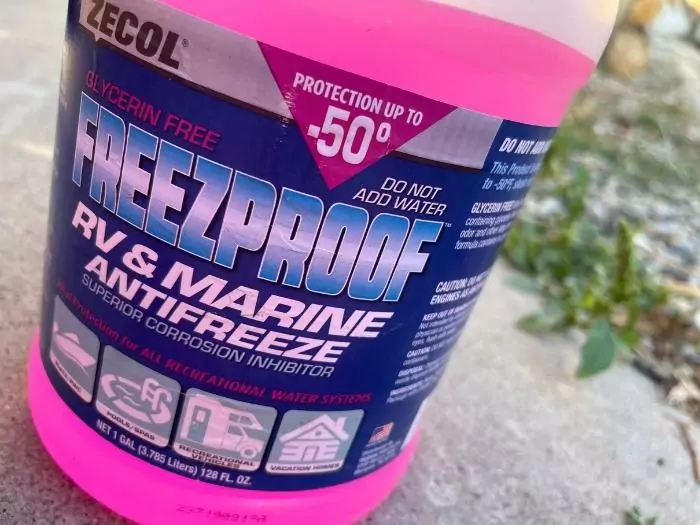
On average you will need between 3 and 5 gallons of RV antifreeze to adequately winterize your water systems.
Here is an estimate of the amount of antifreeze you need based on your rig size:
- Small RV or trailer without water tank or toilet – 1gallon
- RV under 18 ft. – 2 gallons
- RV 18-28 ft. – 3 – 4 gallons
- RV 28-40 ft. – 4 – 5 gallons
It takes at least a couple of gallons to clear out water from a medium-size RV. Larger RVs will need more, and you can probably do fine with just 1 gallon if dealing with a smaller van.
If you did not bypass the water heater, which means you will have to purchase much more antifreeze to keep it safe (probably 6-10 gallons more).
5. Inspe ct The RV Properly Before Putting It Away For Winte r
Climb onto the roof of your RV to check the cracks, holes, cuts, or any openings where water might leak through. Use a proper sealant if you find gaps, and inspect this sealant at least once a year.
6. Open Air Storage Of RV Is Horrible For Your Vehicle
If possible, always get your RV into a garage instead of open storage because the cold will not be kind to your RV’s exterior. But if that’s not possible, the other option is to store it under some structure that can keep it safe from the elements even if you can’t do anything about the cold. Purchase a good-quality RV storage cover to protect the exterior and the tires should also be covered.
7. Store Your RV Where Tires Won’t Move
Put your RV on the emergency brake and apply the wheel chocks to keep it from moving. Also, take some of the pressure off the tires during winter.
Common RV Winterizing Questions (FAQ)
Can you winterize rv without antifreeze.
Winterizing an RV can be completed with the compressed air method, antifreeze method, or a combination. Using compressed air to blow out the entire water system you will not need to add RV antifreeze.
What makes antifreeze worthwhile for RV winterizing is that it does a better job protecting your plumbing and water tanks than attempting to blow out the water to prevent freezing.
If you plan on plumbing and water tanks than attempting to winterize without antifreeze, expect to spend more time using compressed air to empty your outdoor shower head, gray and black water tanks, faucets, toilet, tub, etc. Open the lowest point in your plumbing to let the water drain out.
How Cold Does It Have To Be For RV Pipes To Freeze?
W hen temperatures drop to around 30°F, the possibility of RV plumbing freezing increases rapidly. Water freezes and expands at 32°F causing pipes to burst.
Anything below 32 degrees it is necessary to empty all water and foodstuff from the vehicle in preparation. You can prevent this by storing the RV indoors in a garage where you can control temperatures.
Can You Live In RV In Winter?
Winter camping is quite common, and it’s still possible to use your RV during winter but with several adjustments.
For instance, you may choose to camp in your RV and not use water or use tank heaters to keep water flowing and the rig’s interior warm and cozy. But if you’re not plugged and don’t have a massive supply of generator fuel, you must be prepared to handle the cold using other means. Some people pump gallons of antifreeze into their water tank to pump the water and use it to flush the toilet.
Final Thoughts on Winterizing your RV
Before thinking of traveling during the cold months, make sure you completely winterize your RV. You don’t want to be stuck in the middle of somewhere with frozen pipes.
Here are some winterizing resources to read more about it.
- Can Rv Antifreeze Freeze? What You Need to Know
- Is it Safe to Reuse RV Antifreeze?
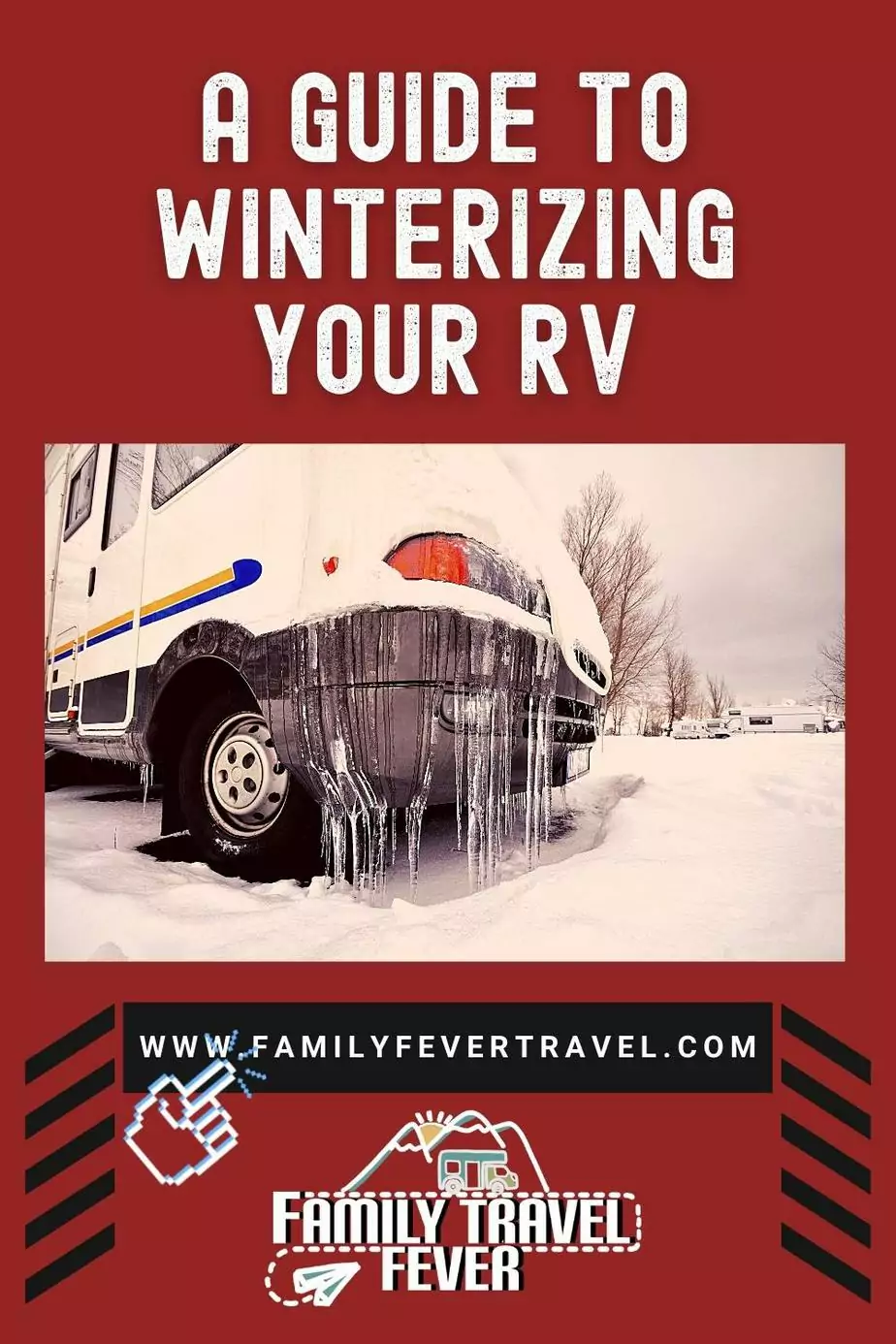
Get this 19-page Travel Planner that I personally use for our family trips
We respect your privacy. Unsubscribe at anytime.

Hi, I’m Shauna – Welcome to Family Travel Fever. We are a large family, that was bitten by the travel bug! I take the kids by myself because I don’t mind flying or driving solo with my crew to discover the coolest places.
Sign up for our email list for my best travel tips plus get the family travel planner free.
Similar Posts
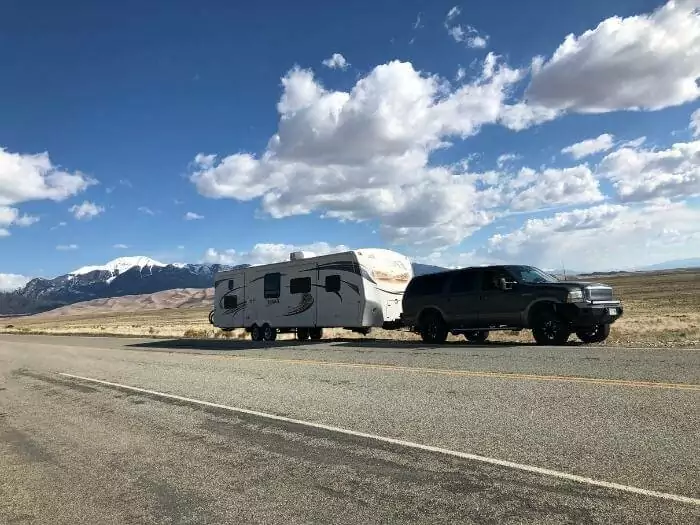
What’s the Difference Between a Motorhome, RV, Camper, and a Trailer?
With the different kinds of RV available, it may get confusing for some people. To prevent you from buying or renting the wrong one, this article will help you understand the differences.
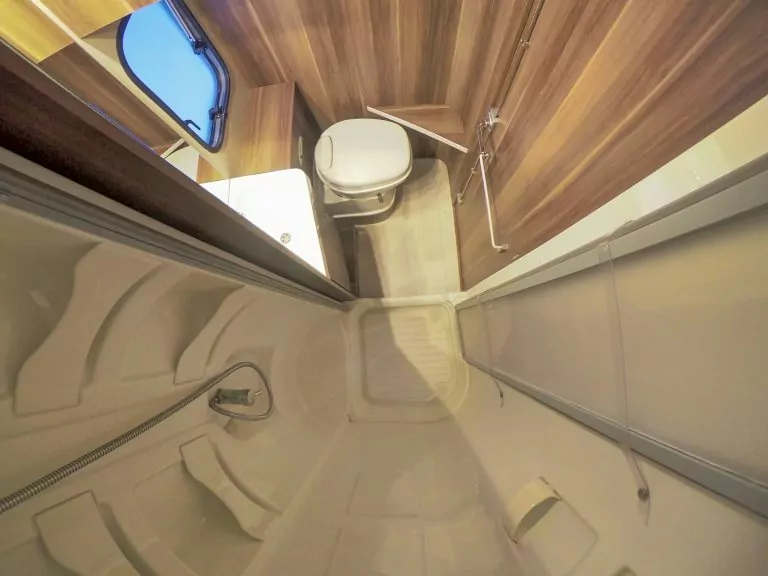
Can I Pee In The RV Shower? (Grey Water Tank Questions)
The gray water tank is the “cleaner” water tank in an RV compared to the black water tank. Whether you can pee in the shower is a common question. We talk about urine in the gray water tank and more!

Earn Money Renting Out an RV on Your Property (Read This First!)
In general, you can rent out your RV on your property if your local laws and neighborhood allow it. Read this article to learn more about renting your RV on your own property.
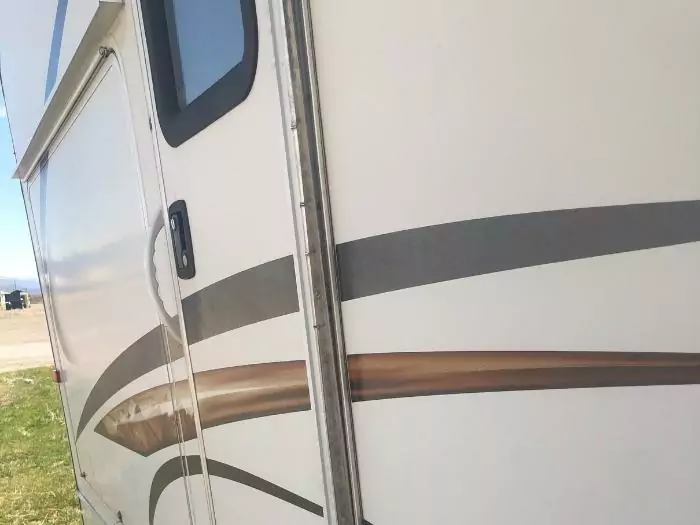
How to Replace an RV Door
An RV door is one part of your RV that gets used every day but is usually taken for granted. When the wear and tear finally take its toll, how do you replace an RV door?

How to Rent an RV to Live In: The Essential Guide!
Are you considering renting an RV to live in? Is it even possible? When you rent an RV for you to live in, there are several things that you must ….
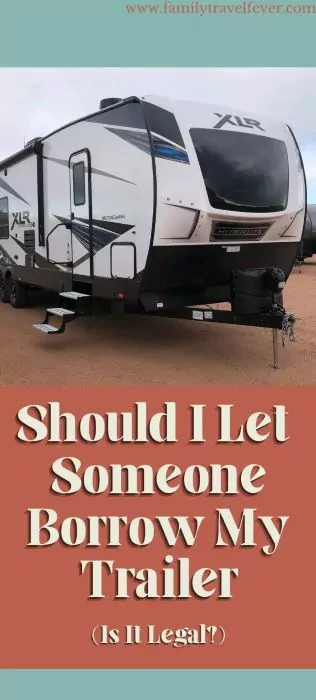
Should I Let Someone Borrow My Trailer? (Is it legal?)
Are the owner that is considering lending out your trailer or you want to borrow your friends trailer? Proceed with caution. Insurance coverage questions are answered in this article.
Leave a Reply Cancel reply
Your email address will not be published. Required fields are marked *
This site uses Akismet to reduce spam. Learn how your comment data is processed .

- Books & Merch
- Gear We Use
- National & State Parks
- Best RV Campgrounds in New Hampshire
- Best RV Campgrounds in NC Mountains
- Best Florida Beach RV Campgrounds
- South Dakota
- The Great Lakes
- Campers Swear By This Portable Device That Keeps Dogs Safe -The Best Portable Dog Fence for Camping (2024)
- Mosquitos and bugs
- Camping Clothes
- Camping Gifts
- Camping Internet
- 5 Best RV Backup Cameras for RV & Trailer
- 7 Best Screen Tents for Camping (2024)
- Best RV Campgrounds in California
- 5 Best Key West RV Parks
- 9 Best RV Campgrounds in New Jersey
- Camping Reservations
- Campground Comparisons
- Cheap or FREE RV Camping Sites
- Best RV Campground Memberships & Clubs
- Boondocking 101
- Boondocking Adventures
- RV Internet
- What Do Flamingos and Upside Down Pineapples Mean?
- Where to Find FREE or Cheap RV Sites Camping
- RV Winter Camping
- RV Show List for 2024
- 17 Best Camper Vans 2024 (New Class B RVs Available!)
How to winterize an RV: The complete guide
If you live in cooler climates, you need to know how to winterize an rv. in late fall, that is job one..
- 1 If you live in cooler climates, you need to know how to winterize an RV. In late fall, that is job one.
- 2 How to winterize an RV: What you need to do
- 3 Winterizing an RV means protecting the pipes from freezing
- 4 The different ways of winterizing an RV
- 5 What temperatures should concern you
- 6 Get the RV Antifreeze in – the “Pink Stuff”
- 7 Todd's trick on how to winterize an RV
- 8 The hardest part of how to winterize an RV
- 9 Dump the holding tank
- 10 Never dilute the antifreeze
- 11 How to winterize an RV water heater
- 12 Don't get scalded!
- 13 Where to next?
- 14 Check out this Southwest Adventure Guide Bundle (Arizona, Utah, & Colorado)
This week, we talk with a Master Certified RV Technician and one of the country's top RV experts to learn when, how, and exactly what steps to take to protect the plumbing system of your RV from cold weather.
Our guest on Episode 418 of the RV Podcast is Todd Henson, Director of Education for the National RV Training Academy . Also known as “the Beard,” Todd is the lead technical instructor for a very popular home study RV tech training course that teaches everyday RVers how to do basic maintenance and repairs.
You can watch a video version on our RV Lifestyle YouTube Channel in the player below:
For an audio version, you can hear the RV Podcast through your favorite podcast app or through the player below:
Podcast: Play in new window | Download (Duration: 44:05 — 61.2MB) | Embed
Subscribe: Spotify | Email | TuneIn | RSS
How to winterize an RV: What you need to do
Here's an edited transcript of our interview with Todd:
Mike Wendland:
As the weather turns colder, we want to talk about winterization. And then, if I could bring you back next week, I'd like to talk about storing your RV. Because there are so many new RVers who are going to encounter their first batch of winter weather very soon, and even some of the experienced RVers are a little unsure of a couple of things. Winterization and storage. This week let's talk about winterization. When do they need to winterize those RVs?
Todd Henson:
Winterizing an RV means protecting the pipes from freezing

Okay. Now, here's the thing. When we are talking about how to winterize an RV, what we're trying to do is protect our plumbing from freezing water. We know as water freezes, it expands and that water is under pressure. It's in pipelines. It just has no place to go, so it ends up causing problems. It creates cracks. And then as soon as we go back out, we turn on the water, of course, we have a huge problem. So when do we winterize, of course, is whenever the temperature outside begins to drop.
Now, where it's difficult is, is for how long? Right now here in Texas, we're enjoying our second spring, so it is getting upwards in the 90 degrees, low 90s in the afternoon, but when we wake up in the morning, we're in the low 50s. The problem that we have is, as we continue to get into October, that number's finally going to come down, and again, we may be in the 70s in the afternoon, but in the 30s in the morning. And that's the deadly time for us as RVers, because even for a few hours, when we have a half-inch line, it doesn't take very long to freeze those.
So let's talk about the different types of winterization processes that we can do. But the first and foremost, we're talking about when. First off, if your season is over, obviously you want to go ahead and winterize. So in other words, you're back home, but you're not scheduling anything through the winter months, through the autumn months, that would be the best time to do it. It is best to do it when it's not freezing.
BONUS: Ever wonder about camping in an RV that has been winterized? Here's an article on how to do meals and cleanup in a winterized RV
The different ways of winterizing an RV

If you're still RVing out there, one of the things that you can do is if you can, keep it plugged into shore power. And if you have a four-seasons RV or all-seasons… They give it different names… And if you have tank warmers, turn those on. Turn your furnace on or Aqua-Hot system.
Now, you don't have to keep it at 70 degrees, but you can set that down to its lowest temperature, maybe 50, 55 degrees, save your propane or save your fuel, whichever one you're using. But you want to pretend like you're living in it. If you can pretend like you're living in it, that's just as good as winterization. Now, there are three different types of winterization.
So if you have your heaters on and the temperature inside the RV is 50 if you have those tank heaters, you're good for most of the winter at that temperature when it's cold?
Two years ago here in Texas, we had that freak snowstorm where we got negative 20. I didn't winterize, I just pretended like I lived there. So I kept the furnace up. I mean, I was changing out my propane tanks every day. But yeah, we set the furnace down to about 50 degrees.
I turned on the tank warmers and left the water heater on, and not a problem. I mean, it was 20 below 0 for several of those days, and it runs just fine. As long as you can create enough heat inside the RV and in the storage bay, yeah, you don't have to winterize.
Full-timers who don't know how to RV and they stay in the winter states, it's the same thing. They just live in it, so you just keep it warm.
What temperatures should concern you
But there's a lot of folks who are just going to be putting their RV to bed, so to speak, for the winter season. And I want to go back to that half-inch line, because I have heard a lot of people say you really have to do it as soon as the temperature is at say 28 degrees consistently for several hours. If it warms up to 50s and 60s in the daytime and then at night, you got a couple of days in there. Is that true or are they playing with fire?
Bonus: What happens if you are stuck in freezing weather while on the road while? Read these Crucial Winterizing Tips for Campers Caught in a Sudden Cold
If you're asking me when, I want to go on the safe side. But yes, you determine your own level of risk you want to take. I can tell you that it is totally true for us and our own experience, is a couple hours a day or something like that, it's not going to damage the lines.
I just don't want that to be taken as gospel because there's different factors out there. What is a couple hours to some… If it gets above freezing, let's say if it stays up to 35, well, that water's still going to be really cold. And so by the next morning where it only takes a couple hours, it's that much closer to freezing.
So yes, in a practical application, a couple hours.
But again, let's look at it from a standpoint if you're done for the season, it's best to do a lot of the things that we do on the RV when the temperatures are moderate.
We shouldn't wait until it's nearly freezing to go outside of the RV and begin to do maintenance. It doesn't make sense. Do it whenever the temperatures are nice and okay, if you're putting it up.
All right, now let's talk about what they need to do. Realizing, of course, every RV is different and has its own unique instructions; look in the manual. But what are the things we need to do?
Get the RV Antifreeze in – the “Pink Stuff”

Okay. Now, there's a couple different ways out there that you can quote “winterize,” and I really only choose one. I prefer one. And that, of course, is to use a propylene glycol or food grade antifreeze. The other version is to blow it out.
Let me quickly cover that. If you blow out your lines, what you're trying to do is vacate all of your plumbing lines, vacate the water, and just simply insert air.
A couple of considerations. Your lines are not able to handle a lot of the pressure that an air compressor can push, so you really want to set that pressure down below 60 psi, probably around 50 psi.
But the problem that I see with this is, especially with a lot of our appliances, as I'm pushing that water out, I don't have just straight lines, I've got coils inside.
BONUS: Click here for a complete playlist of winterization videos showing step-by-step instructions.
If I have a tankless water heater or something like that, I've got coils. If you have an Aqua-Hot system, you've got coils, and that's where water sits.
Well, as I'm pushing that water up and out, I'm not going to get it all out, so as soon as I stop the pressure, water falls right back down. But we also have bends and curves. We've got check valves. I've got pressure until it gets on the other side of that check valve, then I can still have water.
To me, it doesn't make sense to use air pressure to push it out. As a matter of fact, if you have an Aqua-Hot system or many brands of our tankless water heaters, they will tell you in the manual, do not use compressed air. I know it's out there, and for a lot of people, they're able to pull it off. So I want to recommend using just food-grade antifreeze.
The pink stuff.
The pink stuff, correct.
And really honestly, the best place to get that is at your local auto parts store. So the same supplier that supplies most of the RV dealerships also is the same supplier for the local auto parts stores, and so they'll have it there in most cases.
I know you can get it at the big box stores, the marts that begin with Wal and whatnot, but you can also get it at your local auto parts store. They won't know what it is. You'll just have to say the pink stuff and say, “Hey, that stuff over there with all the dust on it.”
Todd's trick on how to winterize an RV
But I want to show you. I can walk up on any RV out there with one little attachment, and you can actually winterize the system by pumping in food grade antifreeze.
So I want to show you. What it is, is just a half-inch line that I have here, just a clear line. It's a half-inch. Now, this is clear. It doesn't have to be clear. I just got this at the big box store. But I also got a half-inch barb fitting to a half-inch national pipe thread, which is NPT. I never could say it right. NPT.
Here's the thing. All RVs have a water pump somewhere.
All RVs have a water pump somewhere. If we can just simply get to the water pump and disconnect the inlet side to the water pump and connect this hose to that water pump. On the other side of that hose, we actually put this in our food-grade antifreeze.

So right here, I'm using just a five-gallon bucket, and I'll talk about that here in just a second.
All right, here's the thing. If you have a five-gallon bucket and this tube right here, then it's just a simple process. Again, if we take this and connect it to the inlet side of our water pump… And the inlet side is actually easy to find because there's always going to be a strainer right in front. Just simply take it off, no tools required. Disconnect that. Reconnect this.
We're redirecting where that water pump is getting its fluid from. In this case, it's going to be a five-gallon bucket. Now if you have, say, a small travel trailer, two gallons will be enough to completely winterize your RV. If you have a larger fifth wheel, a Class A, four to five gallons.
Add a gallon if you have a dishwasher. Add another gallon if you have a washing machine, so maximum of seven gallons of fluid. This is why I have a five-gallon bucket.
If you can get to the water pump, then on any RV out there, all we do is just simply redirect where we're getting our fluid from. We go inside to our control board. Whatever control board we have, we just simply put it on water pump.
We want to go to each and every faucet that we have. We do one side first. So let's say cold side first. So open the cold and let the clear water come out until the pink comes in. Turn that off, and then the hot side.
The hardest part of how to winterize an RV
The hardest part is remembering every single water appliance we have. So you got your faucets, your toilet. If you have an RV style toilet, on the back of that toilet, you have a vacuum breaker, and there's a small amount of water there. You need to flush the toilet until there's pink.
Outside, if you have an outside kitchen or an outside water hose or a faucet, whatever there may be, cold side, then hot side. You could do it either way, hot side first, then cold side. You want to run all of that until the pink comes out.
If you have a washing machine, reason for the extra gallon is you're going to have to run that load until pink stuff gets into the washing machine. We want to protect, of course, the components and the lines going into the washing machine. And the same thing for our dishwasher should we have one.
If you have a residential style refrigerator that has a ice maker connected to it, go ahead… The manufacturer recommends running the pink stuff into the ice. So that just means whenever you come back out, your first couple drinks, just get an umbrella because it's going to be pink ice.
Now, it's food grade antifreeze. It's not going to hurt you, but you'll probably have to take that ice and dump that out until you get clear ice.
One option is, is you can shut off the water flow to your refrigerator. You should have a cutoff. Now, most RVs now, they're putting that cutoff on the outside of the RV. If your RV's just a couple years old, it may be somewhere in the kitchen under the sink just like it would be in the house.
If you simply cut that off, you still have the water going up to the freezer, so what I would recommend, if you do decide to do that, get you a small bowl.
Disconnect that line once you shut it off and let the water drain back into a bowl. Now you've vacated that water there. Keep running the ice maker until all the ice is out, then simply turn it off.
Dump the holding tank

The one thing I failed to mention from the very beginning, that is to dump your holding tank. If you have water in your holding tank, you want to go ahead and dump it. Same thing for your gray tank and your black tank.
Now, it's up to you if you want to leave a third of water in the black tank. No matter what, we're going to get some considerations with the black tank whenever we winterize. If you completely dry it out, just know that you're going to have dry pyramids when we get back out of the winter months.
There's no water in there for the bacteria to break down the solids.
So either way, as long as you're not above a third on there, and even with that, I think that's still playing with fire. I'd rather just keep it empty.
We would presume water would rise as it freezes, but sometimes the weight of water itself won't rise and it'll just push out on the side. So just dump them all and just know that you're going to have to take care of that whenever you're done.
Low point drains. If you have low point drains, open those up until the pink stuff comes out and then close it. So once you do that, your showers… I mean, again, the hardest part, is remembering everything. But once you get all that done, you have pink stuff everywhere.
Now, I know a lot of people will say, “Ah, what about the p-traps?” Well, you actually take care of the p-trap because, of course, you turn on the faucet until the pink stuff comes out. Do both sides. Turn on the faucet until the pink stuff comes out.
Never dilute the antifreeze
Don't mix it. It actually comes 100%, and that's what we want. If you look at the food grade antifreeze, depending on the brand you have, it'll say it's good until about negative 25 or negative 50. The neat thing about this food grade antifreeze is even at negative 25, if it freezes, it doesn't expand. It just turns into a slushy, so your lines are still taken care of.
A lot of the newer motor homes and RVs have a on-the-side utility access point where you can actually hook up that hose as well, so you can do it from outside without having to even bother with the water pump. Is that correct?
Yeah, if you have a wet bay system, you'll have to look at the guidelines with the levers. And then from there, what you're doing is you're going to use your internal water pump. Now, the water pump that we have, the on-demand water pump, it pushes better than it sucks, so get a hose.
But in this case, I've got a three-foot hose. I would still do the same thing. I would put my antifreeze in here, and I would take the small hose and I would hook it up just like I would the regular hose going to the city. Hook this into the wet bay.
Take the other side and put it in the five-gallon bucket. Because again, the pump itself, it can't really pump through a 20-foot hose. We don't really want to use a 20-foot hose. Just get a small one, because remember, it pushes better than it sucks.
How to winterize an RV water heater
What about the water heaters? We haven't talked about the water heaters. We got the plumbing system set, but how about water heaters? Every one's different. Again, I know that. Yeah?
Yeah. So if you have a tankless water heater, pretend like it's not there and let the food grade antifreeze run through. Even though they're tankless, there's a small reservoir. Well, that small reservoir isn't that much, so let the food grade antifreeze go through there.
The problem with those, like I said, is just like with the Aqua-Hot system, they have a burner assembly. Then they run the lines around that burner assembly, and that's how we heat up the water. Well, again, if I have coils filled with water, I can't blow it all out, so I'll just run the food grade antifreeze through them.
So if you have a tankless system, instant hot, whatever you want to call it, or a Aqua-Hot, a hydronic system, use the food grade antifreeze.
If you have a tank system, two different ways. If you have your water bay system, wet bay system, of course, when you put it on winterize, you're bypassing what's in the water heater. What we want to do now is vacate the water in the water heater.
So the steps on that is we have hot water in there, upwards of 140 degrees. We don't want to just go over there with our socket and start taking it apart. It's too hot and it's under pressure.
So what we're going to do is turn off the heat, and the best way to do that is go to your control board and just simply turn your water heater off. Now, from there, you've got no more power going to it.
What you could do is go to a faucet. And as I say before you did your food grade antifreeze, turn on the hot water. Leave the pressure, leave the water going into the hot water, because all pressure comes from the cold water side.
So as you turn on the hot water faucet, you're pulling out the hot water and you're pushing regular cold water back into it. You will know when you got all the hot water out, because, of course, all you got to do is just touch the water, and once it's room temperature, you know you've replaced the hot water, which is fine. So let's do that.
Don't get scalded!

So now the situation is I've got room temperature water in my water heater. So now I turn off the faucet, go outside. It's still under pressure. Whenever we heat up water, the top of our water heater, there's always that air pocket. That air pocket is for expansion.
That can get upwards of 150 psi, so we don't want to go wrenching on that. So you have a P&T valve up top, a pressure and temperature valve. Up there, it's a spring-loaded handle, so we just simply step aside, and what we're going to do is we're going to relieve the pressure.
I've got high pressure on the inside, so I'm going to just open that up, step aside, and water's going to spew out, and it'll spew out for a second. Then it'll just simply stop and you'll hear it inhale. Now we've equalized the pressure on both sides.
Depending on the brand… And I already know the sizes. If you have a Suburban, you want to get a 1-1/16th-inch socket, deep well socket, to take out the anode rod. If you have a Dometic or Atwood, it's going to be a 15/16th-inch socket. So in either brand, again, we're going to turn off the heat to it. We're going to pull the hot water out.
We're going to relieve the pressure. Then we could take out the anode rod out of the Suburban or the drain plug out of the Atwood or Dometic. Let that water drain.
Now, if you let it drain and there's still water pressure going in there, well, you're kind of defeating the purpose, so what we have to do is turn off the water now.
So we go outside, whether we're using city water, whatnot, turn that off, let that water drain. If you have a Nautilus system, boom, you just simply turn it to winterize, and you have shifted where that water is going and it's no longer going to the water heater.
If you don't have a wet bay system, this is where you have to crawl in the RV and figure out where your water heater is. And if you can't figure it out, the best place to start is outside. So you get outside your rig. Is it going to be on street side or is it curbside?
Okay, well, it's on street side. It's roughly in the middle. So now you go inside the RV, you figure out roughly in the middle. There's probably some cabinet there. Down below, you have to get behind the water heater.
And behind the water heater, you're going to have a selection of valves, and this is where it gets really different.
What you want to do is put those valves in bypass mode. So you want to look at your manual to find out which way you turn your valves.
The bypass means is all pressure comes from the cold water side, so cold water is going into the water heater and simply comes out. And what we want to do is bypass that water heater. Let the cold water now go up into the hot water lines and go this way, not back into the water heater. So that's why we're actually turning those shutoff valves.
So again, depending on the brand, I can get you all the way to there, but because each OEM does their valves a little bit differently, that's why I have to recommend you look at the service manual.
Now we've got it winterized, right?
Now, the next step, and that's what I'd like to continue this conversation next week and talk about how we store our RV. What do we need to do now that we got it winterized when we're putting it away for a couple of months at least? So would you come back with us next week and talk about that?
Yes, we can do that.
Todd Henson, it's great. And again, I want to thank you so much, and we are so excited to be able to also urge people to take this awesome RV maintenance class that you guys make. It's all online, it's all so easy. You are the rockstar of this thing. And we will put a link to that – https://rvlifestyle.com/rvtechcourse
But we'll see you next week as we talk about storage.
All right. Thank you so much.
Where to next?
Check out this southwest adventure guide bundle (arizona, utah, & colorado).

When Jennifer and I travel to the southwest, we are continually amazed at the majesty and beauty this country has to offer. And it's really hard to stay in just one state! So we created this Bundle for you in case you like to travel as we do.
We put together our Southern Utah Guide, Colorado Guide, and our NEW Arizona Guide into this 3-State Bundle at a very reduced price!
Each of these RV travel guides is a seven-day guided exploration of some amazing places to explore in these states. And each stop is a curated view of the best things that we’ve enjoyed on these trips and want you to experience.
All together these guides are over 300 pages of content!
Published on 2022-10-19
Mike Wendland is a multiple Emmy-award-winning Journalist, Podcaster, YouTuber, and Blogger, who has traveled with his wife, Jennifer, all over North America in an RV, sharing adventures and reviewing RV, Camping, Outdoor, Travel and Tech Gear for the past 12 years. They are leading industry experts in RV living and have written 18 travel books.
2 Responses to “How to winterize an RV: The complete guide”
October 20, 2022at7:41 pm , Mike Mitchell said:
This article fails to mention that there are two types of RV antifreeze. It does mention propylene glocol, but fails to mention ethylene glycol, which is what most people get because it’s cheaper. When people read “food grade” they are going to equate that with “non-toxic”. Propylene glocol is, by far, the better choice, but there should have been at least a brief discussion of the two types of RV anti-freeze.
October 22, 2022at9:18 am , Team RV Lifestyle said:
Thank you for adding this to the discussion, Mike – Team RV Lifestyle
Leave a Reply Cancel reply
Your email address will not be published. Required fields are marked *
Related Posts

RV Recalls and High Fuel Prices to Impact Summer RV Travel

RV living on a budget: Insider tips from top influencers

Dangerous Weather while Camping: Staying safe in storms
- PRO Courses Guides New Tech Help Pro Expert Videos About wikiHow Pro Upgrade Sign In
- EDIT Edit this Article
- EXPLORE Tech Help Pro About Us Random Article Quizzes Request a New Article Community Dashboard This Or That Game Popular Categories Arts and Entertainment Artwork Books Movies Computers and Electronics Computers Phone Skills Technology Hacks Health Men's Health Mental Health Women's Health Relationships Dating Love Relationship Issues Hobbies and Crafts Crafts Drawing Games Education & Communication Communication Skills Personal Development Studying Personal Care and Style Fashion Hair Care Personal Hygiene Youth Personal Care School Stuff Dating All Categories Arts and Entertainment Finance and Business Home and Garden Relationship Quizzes Cars & Other Vehicles Food and Entertaining Personal Care and Style Sports and Fitness Computers and Electronics Health Pets and Animals Travel Education & Communication Hobbies and Crafts Philosophy and Religion Work World Family Life Holidays and Traditions Relationships Youth
- Browse Articles
- Learn Something New
- Quizzes Hot
- This Or That Game New
- Train Your Brain
- Explore More
- Support wikiHow
- About wikiHow
- Log in / Sign up
- Home and Garden
- Heating and Cooling
- Winterization
How to Winterize an RV
Last Updated: March 25, 2023 Approved
wikiHow is a “wiki,” similar to Wikipedia, which means that many of our articles are co-written by multiple authors. To create this article, 13 people, some anonymous, worked to edit and improve it over time. There are 9 references cited in this article, which can be found at the bottom of the page. wikiHow marks an article as reader-approved once it receives enough positive feedback. In this case, 94% of readers who voted found the article helpful, earning it our reader-approved status. This article has been viewed 322,652 times. Learn more...
If you enjoy camping but take to an RV rather than a tent, then you know there’s work to be done at the end of the camping season. When you’re done camping for the year, and it’s time to leave your RV dormant for the winter, you need to take the appropriate steps to winterize an RV. You don't want to find burst pipes come spring!
Draining the Water and Drying the Water Lines
- If your RV does not come equipped with a built-in system, you should clean the tanks out with a wand or a product designed to clean both of the tanks.
- Take all the tanks' contents to your local dump station.
- Flush your toilets a few times to make sure all the water's gone!
- Technically, it's attached to the "Water Intake Fitting."
- Pressure should be 30 pounds per square inch (maximum of 50 psi). [4] X Research source
Adding Antifreeze to the Plumbing System
- From the inside using a water pump conversion kit
- From the outside with a hand pump
- We'll be addressing the water pump with a bypass method. The science behind the pumps is the same. However, without a bypass, you just have to add much, much more antifreeze. Regardless of whether or not you have a bypass, do not drain your water heater before adding the antifreeze.
- Turn off the water heater
- Disconnect the water supply (the above step)
- If installing for the first time, disconnect the hot and cold lines going in and out of the water heater
- Connect the bypass, following the instructions on the package
- Close off the same hot and cold lines and open the bypass
- Approximately 2 to 3 gallons (7.6 to 11.4 liters) of antifreeze should be enough to fill the RV’s entire plumbing system, provided a bypass is installed. If you don't have one, you need as much antifreeze as the water heater can hold, usually 6 to 10 gallons. [4] X Research source
- You may need to flush the toilet several times until the RV antifreeze comes out at a steady rate.
Completing the Final Details
- And as for valuable items, why would you leave them in an RV for six months? And the laundry, well, it's just best to leave everything clean so when you come back in the spring, there's a lot less work to do.
- Check the entire RV for places that bugs or animals may be able to get into. Just because you're not using it doesn't mean they should get to!
- You may want to put rags on top of the sharp corners of your RV so that breathable material doesn't rip. For good measure!
Community Q&A
- Most RV parts stores will have the supplies needed to winterize an RV. Thanks Helpful 0 Not Helpful 0
- Your owner’s manual will have information about the preferred method of winterizing your particular model of RV. Thanks Helpful 0 Not Helpful 0

- Never use automotive antifreeze in the lines of an RV, as this can cause damage to the plumbing system. Thanks Helpful 17 Not Helpful 7
- Be sure to open the pressure relief valve when draining the water heater. Allowing the water to drain while it is under pressure, or hot, can lead to injuries. Thanks Helpful 13 Not Helpful 8
Things You'll Need
- Pump (water or hand)
- Bypass kit (optional)
- Antifreeze (minimum 3 gallons)
- Tank-cleaning wand
- Tarp of breathable material
- Air compressor
- Adapter ("blowout plug")
You Might Also Like

- ↑ http://www.gagscamperway.com/rv/winterize.htm
- ↑ https://www.reserveamerica.com/outdoors/how-to-winterize-an-rv.htm
- ↑ 4.0 4.1 http://www.kinstler.com/how_to/winterize_an_rv/how_to_winterize_rv.html
- ↑ https://gorving.com/what-to-do/winterizing-your-rv
- ↑ http://rvservices.koa.com/rvinformation/rvmaintenance/step-by-step-rv-winterizing-checklist.asp
- ↑ https://www.fraserway.com/discover-rving/blogs/winterizing-101-how-not-burst-your-pipes
- ↑ https://www.parkedinparadise.com/winterize-rv-camper/
- ↑ http://www.doityourselfrv.com/rv-winterizing-winter-storage-information/
- ↑ http://rvservices.koa.com/rvinformation/rvmaintenance/you-winterized-your-rv-but-did-you-prepare-it-for-storage.asp
- http://koa.com/familyzone/camping101/articles/rvmaintenance_506.htm
About This Article
To winterize an RV, start by draining the water from the fresh water, black, and gray holding tanks. You should also open any cold and hot water faucets and flush the toilet a few times to make sure all of the water is out. Next, attach a compressed air adaptor to your RV's water lines and blow air through the water lines using an air compressor, which will force out any remaining water. Finally, add antifreeze to your RV's plumbing system to protect it throughout the winter. To learn how to protect your RV from a rodent infestation during the winter, scroll down! Did this summary help you? Yes No
- Send fan mail to authors
Reader Success Stories
Jim Darrough
Nov 9, 2016
Did this article help you?
Oct 20, 2022
Nov 27, 2016
Judy Stephens
Aug 16, 2017
Bill Arthur
Oct 31, 2016

Featured Articles

Trending Articles

Watch Articles

- Terms of Use
- Privacy Policy
- Do Not Sell or Share My Info
- Not Selling Info
wikiHow Tech Help Pro:
Develop the tech skills you need for work and life

The Savvy Campers

When to Winterize a Travel Trailer
If you have ever owned or considered purchasing a travel trailer, you know how costly of an investment it is. Unless you live in a warm climate, you will need to appropriately winterize your travel trailer. If you choose not to winterize your travel trailer, you will likely incur extreme costs in repairs.
When do I winterize a travel trailer? The answer varies depending on the geographic location you live in, as the climate varies by location. The general rule of thumb is to winterize your travel trailer when the temperature is at or below 32 degrees Fahrenheit and will be so for a prolonged period of time.
To ensure the quality and longevity of your investment, winterizing is non-negotiable. Failure to winterize your travel trailer will prove to be a very costly mistake. For a step to step guide on how to winterize, here is our complete guide.
What Happens if I Don’t Winterize my Travel Trailer?
If you choose not to winterize your travel trailer, there are many damages that are likely to occur, such as.
- Broken pipes
- Damaged water pump
- Damaged sink valves and traps
- Damaged toilet valves and traps
- Cracked tanks
- Cracked drain lines
As you can see, there are many things that can go wrong when you fail to winterize your travel trailer properly. All the problems can be repaired, but it will be expensive, and you will lose time with your travel trailer while it’s in the shop. Let me tell you, if you can avoid the RV shop, do so. Typically it takes a month just to get in during camping season and they charge as much as an attorney makes per hour. (just kidding, but almost)
Can I Winterize the Trailer Myself?
Thankfully, winterizing a travel trailer is something that can be done without the assistance of a dealership or trained professional. If you choose to winterize your travel trailer by yourself, it is imperative that you follow the correct steps. We have our complete guide here that anyone can do with a limted tool kit.
The best place to find the protocol for winterizing your travel trailer is going to be in the owner’s manual. In the manual, you will find the necessary steps to take to ensure proper winterization. There are also many travel trailer forums that you can check out for tips and tricks from other travel trailer owners based on your specific model.
How Long Does the Process Take?
The time it takes to winterize your travel trailer is going to depend on several factors; the size of the trailer, your experience and comfort level with the process, the number of people helping, and the availability of resources and tools needed.
If you have the proper tools, the average time it takes to fully winterize a travel trailer is anywhere from 30 minutes to an hour and a half. Like anything, the more times you go through the process, the easier it becomes. Don’t be discouraged if you take well over 2 hours to winterize your travel trailer the first time. Remember there is a learning curve and efficiency will come with experience. The important thing is to complete the job properly and not to forget anything, such as your black water tank flush.
When is the Best Time to Winterize?
As stated earlier, the best time to winterize is when the temperature is at or below freezing. For some locations, this temperature drop will occur in early fall, while other areas won’t see this temperature until closer to winter. To learn more about how long it takes for pipes to freeze, take a peak at our article on the subject here .
To ensure you have your travel trailer winterized before harsh weather strikes, it is a good idea to keep an eye on the weather. When you see the temperatures beginning to dip into the low 40’s it may be time to winterize.
Some people choose to winterize their travel trailer directly after the final use of the year which eliminates the need to track the weather as closely.
Tools / Supplies Needed
When preparing to winterize your travel trailer, you want to make sure you have all the necessary tools on hand. The last thing you want to do is make trips to the store in the middle of the process. Chances are you have a lot of the necessary tools on hand.
- Antifreeze (RV/Travel Trailer Specific)
- Blow Out Adapter
- Air Compressor
- Water Heater Drain Socket
- Wand to Clean Holding Tanks
- Silicone Spray
- Bug Screens
- Dehumidifier
- Storage Cover
This is quite an extensive list and you may not need all the items. Some items such as the bug screens, mothballs and dehumidifier would be considered optional, but will help to keep your travel trailer pest-free during storage.
Steps to Follow When Winterizing your Travel Trailer
These steps are quite general and may not be applicable to all types of travel trailers. Please be sure to read the owner’s manual carefully before beginning the process to ensure you don’t skip anything.
- The first thing you want to do is bypass and remove any water filters that are present. When closing the travel trailer for the winter you want to make sure the water lines are dry. This is where the air compressor will come in to play as you blow the water out of the lines.
- Drain the water from your tanks. Most tanks are black and gray. Neglecting to drain the water can result in nasty cracks to the tank, which will deem them unusable.
- Drain the water heater and blow out the lines. Again, leaving water in the lines can cause them to freeze and crack.
- Once you have drained the water heater and lines, you will want to bypass it as well.
- Add antifreeze to the travel trailer. This will help ensure no freezing occurs.
Why Do I Need to Bypass the Filters and Water Heater?
It may seem like an added step to bypass an area that has been completely dried out but neglecting to bypass these areas can result in anti-freeze leaking into these components. Thankfully most travel trailers will have a bypass built in, but you may need to purchase the correct parts.
If you need to purchase a bypass kit, you can find several options on Amazon. The average cost of this part is low, and it is relatively easy to install. When looking at the parts, if you are uncertain about which part to get, check your owner’s manual and even reach out to a dealership if needed.
Where Can I Get a Cover?
If you are opting to purchase a cover for your travel trailer you have the option of visiting the dealership, manufacturer, or Amazon. In each of these places, you will be able to find a cover that is a perfect fit for your travel trailer. When purchasing a cover, you will need to have the dimensions of your travel trailer as well as the weight of the cover you are looking for.
The cost of the cover will vary depending on the size as well as the weight, but you can expect to pay between $60.00 and $700.00. If you are looking for a customized cover it will likely be more expensive. For more information about if you should cover your trailer, head over to our guide here.
Where Should I Store the Travel Trailer?
If your travel trailer is properly winterized, you can safely store it outside for the winter if you have the space to do so. It is important to keep in mind the appearance of your travel trailer exterior may diminish with prolonged exposure to extreme elements. Because of this many people opt to cover their travel trailer. Here is a guide to storing your RV at home .
If you live in a location with particularly harsh winters, you may opt to store your travel trailer in a facility that offers protection from the elements. Not all covered spaces are climate controlled so you will still need to winterize your travel trailer to prevent internal damages.
How Much Does Storage Cost?
While renting a dedicated storage space for your travel trailer may be ideal, it can be quite costly. The price will ultimately depend upon your geographic location, but a ballpark average provided by storage.com is:
Again, these prices are an average. You will likely find the geographic location has an impact on the prices you are going to be paying for storage. In our area, they are on the high side of this chart. This is simply based on the supply and demand premise. If you are in a location with harsh winters, the demand for indoor storage units will likely be greater than in a more temperate climate.
Final Thoughts
A travel trailer is a great investment for you and your family; however, it is important to remember the investment will only last if you take the time and care to maintain it. If you are ever uncertain about the method to winterize your travel trailer it is best to reach out to an expert for help.
Be the first to be notified about FREE tips, hints, coupon codes, and email-exclusive information. All for FREE!
Related Posts:
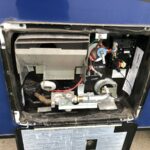
Similar Posts
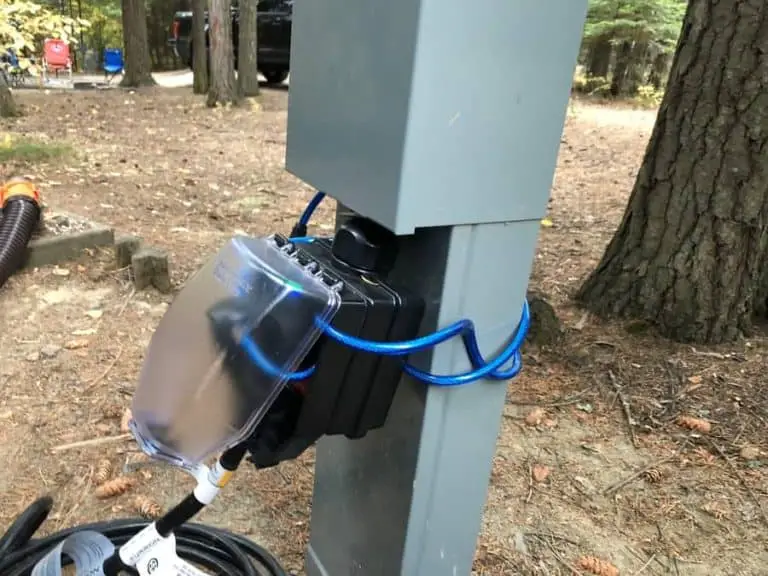
What is the difference between a 30 amp and 50 amp RV?
A 30 and 50 amp system both have the same purpose, to power the RV. However, they are very different and are used in different types of RVs. What is the difference between a 30 amp and 50 amp RV? The difference between 30 amps and 50 amps is how many items you can run…
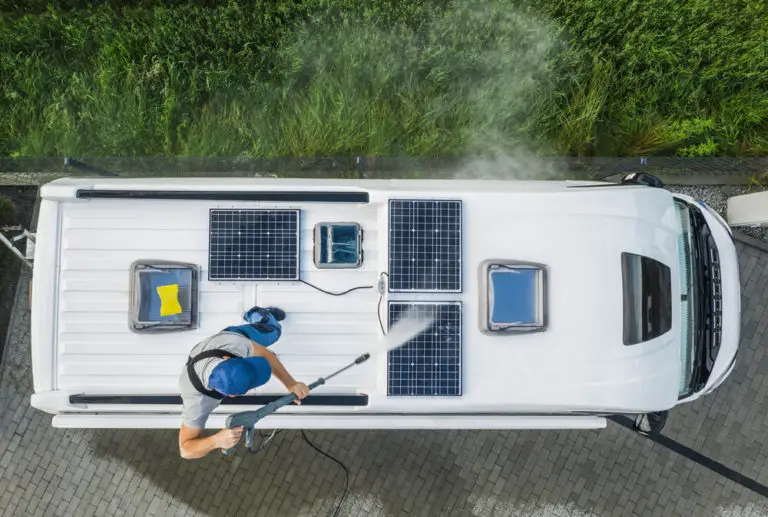
Can You Take an RV Through a Truck Wash?
Being on the road for such a long time, your RV can get dirty faster than expected. However, finding a spot that allows you to wash an RV is not easy. But if you pass numerous signs indicating truck wash ahead, you may consider taking your RV through a truck wash. You can take an…
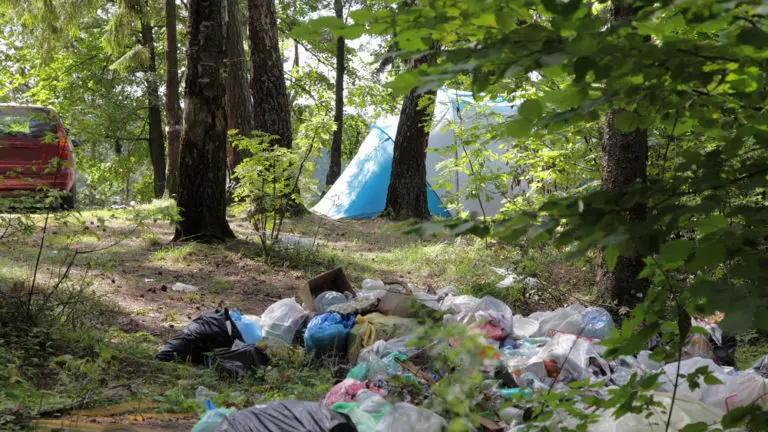
The Best Ways To Store Waste When Boondocking
Boondocking is one of the easiest ways to get away from civilization and experience the wilderness’s quiet, peaceful, raw beauty. As a rule, you should take everything you brought into the wilderness away with you when you leave. This poses a challenge for the waste you produce while boondocking. What are the best ways to…
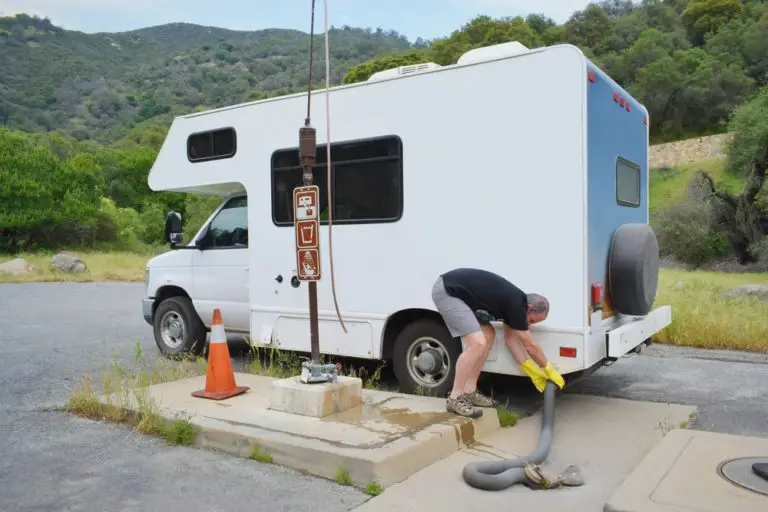
What To Look For When Buying a Used Class C Motorhome: Essential Tips for a Smart Purchase
Class C motorhomes are a budget alternative to the luxurious class A motorhomes. They are smaller and have fewer amenities than class A motorhomes, but are more fuel efficient and cheaper to maintain. The most important things to look for when buying a used Class C Motorhome are the mileage, leaks or water damage, the…
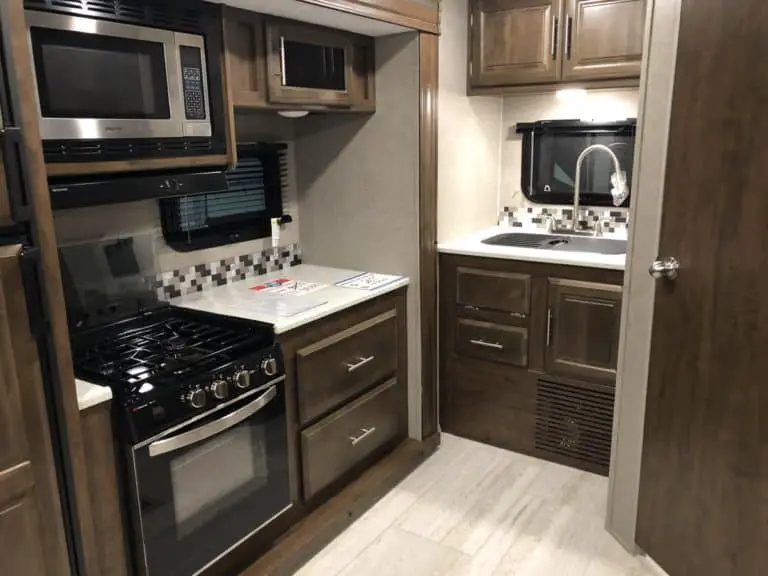
How To Test If Your RV Fridge Is Working On Electric?
Most RV fridges are absorption refrigerators designed to run on 12V direct current or 120V alternating current electricity or propane gas heating. The absorption fridge is designed to be able to switch between any of these three supply settings. If your fridge is not working, no display lights will light up inside the fridge or…
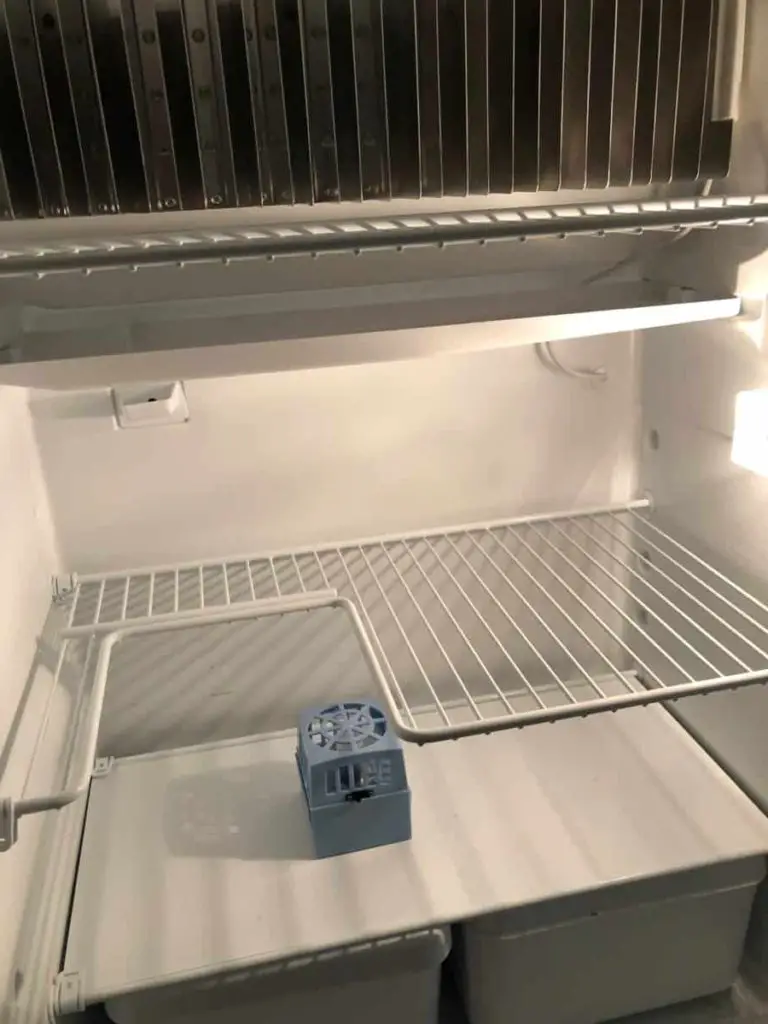
How Long does it take for a RV Fridge to get cold? Plus 4 Quick Tips
Keeping your food, drinks, and items cold while out camping is important to provide you with the best experience and from eating spoiled food. Before you start packing, you will want to cool your refrigerator. How long does it take for a RV Fridge to get cold? It typically takes 24 hours for your refrigerator…
Join our Newsletter to stay up to date on the latest RV topics and receive our FREE RV Inspection Cheat Sheet Today. Use this tool to inspect new or used campers you are looking at purchasing.
No thanks, I’m not interested!

How to De-Winterize Your Travel Trailer (RV Checklist)
Are you ready to take on the camping season? Before hitting the road, it’s important that you de-winterize your travel trailer. To ensure you don’t miss a beat, we’ve created an extensive de-winterize travel trailer checklist:
How to De-winterize Your Travel Trailer:
- Charge and Re-install All Batteries
- Check the Tires. During winter storage, an RV’s tires will lose about two to three psi of air pressure for every month or inactivity. Also, check depth of the tire tread
- Check the Exterior for cracks, broken seals, and exterior lights
- Flush the Freshwater System of All Antifreeze
- Sanitize the Freshwater System
But that’s just a quick glimpse!
So below, we’ll go through all the necessary steps for a safe and successful camping season. From checking propane tanks and water lines to draining plugs and inspecting batteries, our de-winterize travel trailer checklist has got everything covered.
So don’t delay – get started now with these most important steps so you can hit the open road in no time.
Table of Contents:
De-winterizing the exterior of an rv, de-winterizing the propane system of an rv, de-winterizing the freshwater system of an rv, check all rv batteries after winterization, what should i remove from the rv for winter, when should you de-winterize a travel trailer.
- How do you sanitize a camper water system after Dewinterizing?
Do you have to de-winterize an RV?
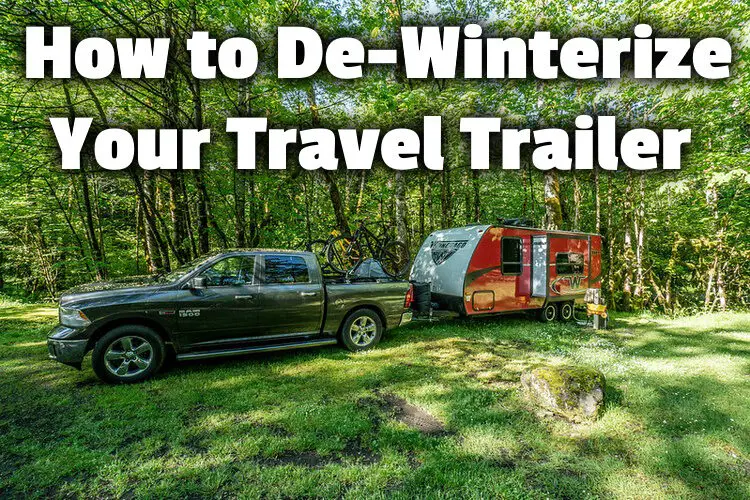
When de-winterizing your RV for the spring and summer, it’s a good idea to inspect the exterior of your vehicle.
This includes checking for any signs of damage from winter weather or animals that may have nested in the vehicle while not in use. Start by looking over all surfaces of your RV, including windows, walls, roof, and tires.
Check for any cracks or holes that could cause a leak or other issues during travel.
Next, check all tire pressure levels to ensure they are properly inflated and safe to drive on. Tires can deflate during cold temperatures so make sure they are filled with air before hitting the road again.
Inspect each tire individually as well as tread depth – if you notice uneven wear patterns this may indicate an alignment issue which should be addressed prior to driving long distances with your RV.
If you have a spare tire, don’t forget about those also!
Tire covers are a great thing to consider for your RV during the downtime in winter as they can protect your RV’s tires from sun, rain, snow, sleet, and cold. They are surprisingly easy to put on and are fairly inexpensive.
Click that link to read all about them on my site.
To maintain the aesthetic appeal of your RV, use a soft brush such as an old toothbrush and a gentle cleaner like dish soap mixed with warm water to clean off any dirt or debris that has accumulated on its exterior.
Use a gentle cleaner like dish soap mixed with warm water along with a soft brush such as an old toothbrush – avoid using anything abrasive which could scratch paintwork or decals on the side of your trailer. Make sure you rinse off completely after cleaning too so there is no residue left behind.
Gently scrub away any accumulated dirt and debris on the exterior of your RV with a soft brush such as an old toothbrush, taking care not to damage paintwork or decals.
Use a gentle cleaner such as dish soap mixed with warm water along with a soft brush like an old toothbrush – avoid using anything abrasive which could scratch paintwork or decals on the side of your trailer. Make sure to rinse off completely after cleaning so there is no residue left behind.
After thoroughly inspecting the exterior of your RV for any damage or wear and tear, you can now proceed to de-winterize it. Moving on to the propane system of an RV, it is important that all components are properly checked before use.
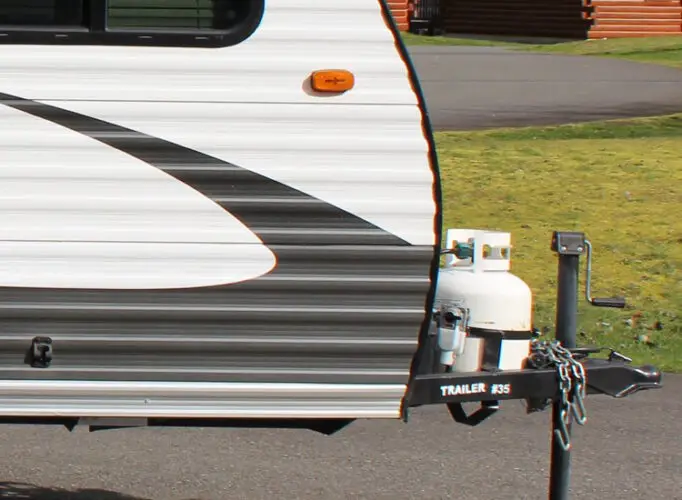
Propane systems are essential for many RV owners, providing the fuel needed to power appliances and heaters. After a long winter, it’s important to de-winterize your propane system before you hit the road. Here’s what you need to do:
Check Propane Tanks:
Start by inspecting your propane tanks for any signs of damage or leaks. Ensure all valves are firmly shut and the container is still tightly sealed. Inspect the tanks for any flaws, and if found, get them substituted quickly before reuse.
Test Connections:
Once you have checked the tanks themselves, test all of their connections with a soapy water solution or leak detector spray. This will help identify any potential leaks in the lines between your tank and other components such as hoses or regulators. If there is a leak present, make sure it gets fixed immediately before turning on your propane system again.
Replace Components if Necessary:
In some cases, parts may need to be replaced due to age or wear and tear from being exposed to cold temperatures during winter storage periods. Check things like hoses, regulators, and other components for cracks or tears in order to ensure they can safely hold pressure when used again this season.
Check Gas Lines & Valves:
Lastly, inspect gas lines throughout your RV for any signs of corrosion or blockages which could prevent the proper flow of gas through them when turned on later down the line – literally. Make sure that all valves along these lines are functioning correctly too; otherwise, you might find yourself stuck without hot water until they’re repaired.
Essential measures should be undertaken to de-winterize an RV’s propane system in order to guarantee secure and proficient functioning. Next, we will look at how to properly de-winterize the freshwater system of an RV.
Once you’re done checking, test all LP gas appliances by lighting the burners and ensuring everything is working normally. Your refrigerator also likely runs on propane, so also check to make sure the fridge is starting to get cold .
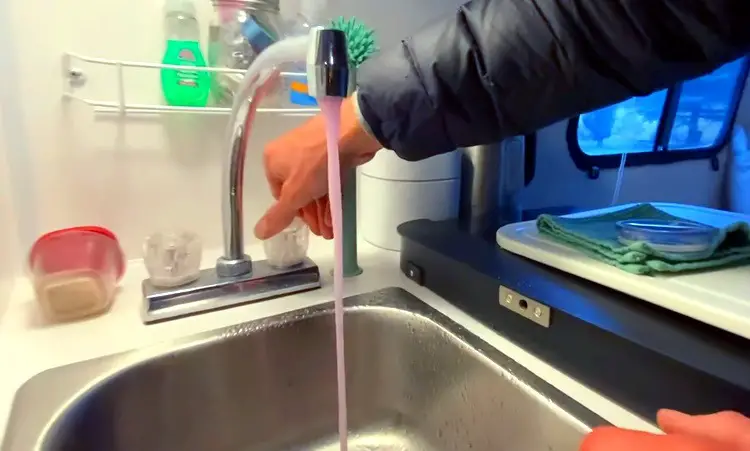
De-winterizing the RV water system is a vital step in preparing for your next camping adventure.
The first step in the de-winterizing process is draining and flushing all non-toxic RV antifreeze from the RV’s fresh water tank, system, and RV water lines, including connections to your hot water heater as well as other fixtures.
If you removed the water filter when winterizing, make sure that gets put back in place.
The step-by-step process is:
- Connect your trailer’s water intake to a garden hose (at your house or campground)
- Turn on the water at the spigot
- Turn on every faucet in the camper including the shower (both hot and cold water in case there is lingering antifreeze in the hot water heater tank)
- Let the water run until totally clear
- Turn off the water at the spigot
- Turn on the water pump
- Repeat the procedure to eliminate any antifreeze in the freshwater tank
This process will fill up your holding tanks, so ideally have that connected at a dump station or campground or have a plan to dump it soon.
If you aren’t able to connect to a water source, this process will still work with a full fresh water tank in conjunction with the water pump.
The last step in de-winterizing is checking all valves associated with the freshwater system to ensure they are opened correctly and do not leak when pressurized.
This can be done by turning each valve handle several times clockwise until tight then back off slightly counterclockwise – if done properly these should remain open without having to constantly adjust them manually every time you want fresh water flowing into your RV.
Lastly, test out all faucets and shower (including an outside shower if you have one) within reach to make sure everything is working properly before hitting those dusty trails once more.
To ensure the freshwater system of your RV is de-winterized properly, be sure to follow all steps in this checklist. Moving on, it’s important to check all batteries after winterization for optimal performance and safety.
It is essential to check all RV batteries after winterization.
Verify that the batteries have been adequately charged to guard against destruction or erosion during storage. Connectors should be cleaned and tightened, while battery fluid levels should also be checked and topped off if necessary with distilled water.
If possible, it’s best to use a battery tester/charger like this one on Amazon when checking the voltage of each battery in order to get an accurate reading. Anything lower than 12 volts indicates that the battery needs charging before being put back into service. If your RV has two or more batteries connected together in parallel, they should both read at least 12 volts when tested individually with a multimeter.
That tester is good for regular as well as deep-cycle batteries, lead-acid batteries, as well as both 6-volt, and 12-volt systems.
You can also test for resistance between terminals using an ohmmeter or continuity tester; anything higher than 0 ohms indicates a good connection between terminals and proper electrical flow through the cables connecting them.
Additionally, you may want to inspect the case of each battery for signs of wear such as cracks or bulges which could indicate internal damage due to overcharging or other issues caused by improper maintenance during winterization procedures.
Frequently Asked Questions
Before winterizing your RV , it is important to remove all food and perishables.
All water tanks should be drained and cleaned with a bleach solution. Remove any batteries from the RV and store them in a warm location. Cover windows, vents, air conditioners, and other openings with plastic or foam insulation to protect against cold temperatures.
Finally, inspect all hoses for cracks or leaks before storing away until springtime. Taking these steps will ensure your RV is properly winterized and ready for the next camping season.
It is important to de-winterize a travel trailer as soon as the weather begins to warm up. In Texas where I live, that would be early March. But if you live in Chicago, that may be too soon.
Here’s a handy chart showing the date of the last freeze regionally around the US:
This will help prevent damage from freezing temperatures and ensure that all systems are functioning properly before taking it out on the road. To de-winterize, start by draining any antifreeze or water left in the system, then flush out fresh water until it runs clear.
Next, inspect all hoses and fittings for cracks or other damage and replace them if necessary. Finally, fill with fresh potable water and check for leaks at each connection point. Taking these steps now can save you time and money later.
How do you sanitize a camper water system after de-winterizing?
To sanitize a camper water system after de-winterizing, it is important to first flush the entire system with fresh water.
Add a quarter cup of bleach for every 15 gallons of tank capacity and fill the tank with fresh water, then proceed to turn on all faucets until chlorine is detectable.
Turn on all faucets until you smell chlorine at each outlet, then let sit for 12 hours before draining and refilling with clean potable water. Lastly, run all faucets again to ensure that any remaining traces of bleach have been flushed out completely. Following these steps will help keep your camper’s drinking water safe and free from contaminants.
Yes, IF you added biodegradable antifreeze to your trailer’s freshwater system, de-winterizing an RV is a necessary step before taking it out for the first time in the season.
Now if you live somewhere mild like Florida, adding antifreeze isn’t likely necessary, in which case you may not need to do much of anything.
But for most of us, this process involves flushing antifreeze from the water lines and draining tanks to ensure that all systems are working properly. Inspecting and replacing any components or accessories that may have been harmed during storage should be carried out, if necessary.
Following these steps will help ensure safe travels throughout your camping adventure.
Today we looked at all the crucial things you must do to get your RV ready after having winterized it during the colder months. From batteries to the fresh water system, to interior and exterior checks, we covered it all.
After following this step-by-step guide, you are now ready to enjoy your RV during the camping season.
Before embarking on your journey, ensure that there are no water leaks or other potential issues present in the RV. Ensure all is in good working order to guarantee a secure and delightful excursion with companions and family.
It’s also a good idea to check and maybe replace batteries in a smoke alarm if your trailer has one.
DSC09424 by Adventures On Wheels and IMG_0081 by JBLM MWR is licensed under CC2.0 and may be cropped, edited, and/or had a text overlay added. Still frame taken from video How to Winterize an RV + What Tools & Supplies You Need | RV DIY by RVLove | Marc & Julie Bennett , also licensed under CC2.0 and may be cropped, edited, and/or had a text overlay added.
Middle Class Dad is a participant in the Amazon Services LLC Associates Program, an affiliate advertising program designed to provide a means for sites to earn advertising fees by advertising and linking to Amazon.com. As an Amazon Associate, I may earn a small commission from qualifying purchases if you click to Amazon from my site and choose to make a purchase. This is no way increases the cost to you.
Jeff Campbell
Jeff Campbell travels on and off with his 3 daughters in a Newmar Baystar Class A Motorhome. He writes extensively on both RVs, campgrounds, parenting on the road tips, remote learning & schooling, and much more! Click Here to learn more about me. Click Here to learn more about my site. Editorial Policies.
Leave a Reply Cancel reply
Your email address will not be published. Required fields are marked *
Save my name and email in this browser for the next time I comment.
Recent Posts
RV vs Regular Toilet Paper: Key Differences
When it comes to choosing the right toilet paper for your recreational vehicle (RV), there are some important considerations to keep in mind. But what's the difference between RV toilet paper and...
Essential Family Camping Gear 2024 Must-Haves
When it comes to family camping, having the right gear can make all the difference in creating lasting memories and enjoying the great outdoors. Whether you're planning a weekend getaway or a longer...

IMAGES
VIDEO
COMMENTS
Open all hot and cold faucets, including those outside the coach, if you have them. Open the fresh water drain on your RV's undercarriage. This could be a valve or a just a cap. Turn off all faucets that you opened in Step 3. Find your city water connection (usually next to your fresh water fill access). Connect the compressor and turn it on.
Add a few inches of RV pump antifreeze to winterize your toilet to the bowl. Next, flush the bathroom several times until the antifreeze appears in the bowl. Inline water filters, turn off the bypass valve, and open all of your RV's faucets until the antifreeze comes out. Step # 4: Disconnect And Drain The Battery.
In this video, we'll go through the step-by-step process of winterizing my 2020 Keystone Bullet 243BHS travel trailer using RV antifreeze. While you may have...
RV Winterizing Your RV Checklist; RV Winterizing Checklist; Final Thoughts. Winterizing a travel trailer or motorhome is not a difficult task. The steps above are very general, and some may or may not apply to your particular travel trailer. I encourage you to check your owner's manual for the exact steps needed to winterize your travel ...
Before you embark on winterizing your RV, your first order of business should be collecting everything you'll need for the process. Items needed to winterize a travel trailer will include non-toxic RV antifreeze, a water heater bypass kit, silicone sealant, and other necessary items and tools. Below is a systematic, step by step guide on how ...
Once drained, turn the water pressure on and flush out the sediment for 2-3 minutes. Remove the anode rod if old and leave it out during winter; make a note to install a new one in the spring. 3. Bypass the Water Heater. Before adding anti-freeze to your RV, you need to make sure you bypass the water heater.
Follow the steps below. Turn off the water pump and release pressure through all faucets and valves. Locate and connect a hose to the freshwater tank drain valve. Allow all of the water to drain by opening the drain valve. Close the drain valve, then remove the hose once the tank is empty.
This step isn't a complete necessity on an RV winterizing checklist, but it never hurts to stay on the safe side when you're dealing with water. Use 30-50 psi of compressed air to clear out any remaining moisture in your plumbing system. Once that is complete, replace the caps on the holding tanks and water lines. 2.
👇 *Click _"SHOW MORE"_* below to open the full video description! 👇*How to Winterize a Travel Trailer - Are you winterizing your RV properly?* Did you kno...
Winterize a Camper for Beginners: Clean and inspect interior and exterior. Disconnect batteries, propane, and solar panels. Drain and clean waste water tanks. Drain the fresh water tank and water lines. Drain the water heater. Prevent pipes from freezing (blow out water lines or pump in antifreeze) Store your RV properly.
This is a comprehensive step by step video to help you learn how to Winterize your RV or Travel Trailer. We show a few different systems and how they work so...
On average you will need between 3 and 5 gallons of RV antifreeze to adequately winterize your water systems. Here is an estimate of the amount of antifreeze you need based on your rig size: Small RV or trailer without water tank or toilet - 1gallon. RV under 18 ft. - 2 gallons. RV 18-28 ft. - 3 - 4 gallons.
1. Drain water. One of the major focuses of winterizing is removing all water from your RV's tanks and pipes. If the vehicle is exposed to freezing temperatures and still has water in the pipes, this can lead to disaster! Improperly drained RVs may experience burst pipes, cracked holding tanks, and severe water damage.
It's CRUCIAL that you use RV-specific antifreeze to winterize your RV's plumbing system. It's bright pink and can usually be purchased from your local dealer, RV supply store, or even Walmart. RV antifreeze is non-toxic and safe to use in fresh water plumbing. Automotive antifreeze, however, should NEVER be used in your RV plumbing. It contains ...
Now if you have, say, a small travel trailer, two gallons will be enough to completely winterize your RV. If you have a larger fifth wheel, a Class A, four to five gallons. Add a gallon if you have a dishwasher. Add another gallon if you have a washing machine, so maximum of seven gallons of fluid.
Learn how to efficiently winterize your RV with this step-by-step guide. We'll discuss the different methods of winterization, both compressed air and RV ant...
To winterize an RV, start by draining the water from the fresh water, black, and gray holding tanks. You should also open any cold and hot water faucets and flush the toilet a few times to make sure all of the water is out. Next, attach a compressed air adaptor to your RV's water lines and blow air through the water lines using an air ...
Regarding 13 Steps to winterize RV's, Step 7, Winterizing the on-board water system, you need to qualify that is not regular automotive antifreeze, which is poisonous. This can be done by stating it should be a RV Water System Anti-freeze, with Propylene Glycol. This can be purchased at RV supply stores and sometimes ACE Hardware.
Use our RV winterizing checklist to help winterize your motorhome or travel trailer. 1. Remove hookups and drain your RV. If you have connected your RV to water at home or a campground, unplug it and turn your water heater off. Next, drain all your RV's low-point drains, which should be easily visible (and easily reachable) underneath your rig.
How to Winterize your RV. You know the time has come. Your RV needs to be stored for the winter. What's the best way to do that? in this episode Todd gives u...
The answer varies depending on the geographic location you live in, as the climate varies by location. The general rule of thumb is to winterize your travel trailer when the temperature is at or below 32 degrees Fahrenheit and will be so for a prolonged period of time. To ensure the quality and longevity of your investment, winterizing is non ...
Here's a quick video for the RV travel trailer owner who wants to winterize their RV in 16 easy steps. Our model trailer is a Visa Ultra Light but the proces...
Check the Tires. During winter storage, an RV's tires will lose about two to three psi of air pressure for every month or inactivity. Also, check depth of the tire tread. Check the Exterior for cracks, broken seals, and exterior lights. Flush the Freshwater System of All Antifreeze. Sanitize the Freshwater System.